There are more than thousands of different mushroom species out there, and each one has its own special features. Some of them have rings around their stems or even a little skirt. Whether a mushroom has a ring, a skirt, or neither can be really important when it comes to figuring out what kind it is. Every detail counts when identifying a mushroom.
In this article, we’ll dive into how these stem rings and skirts are formed, what they mean (if anything), and the common types of mushrooms that have these features. There are quite a few ways these skirts and rings take form, so it’s not always enough to simply say the mushroom has a skirt or ring around the stem. The ring or skirt should also be investigated to see if it’s a single or double, short or long, or easily moveable, among other things.
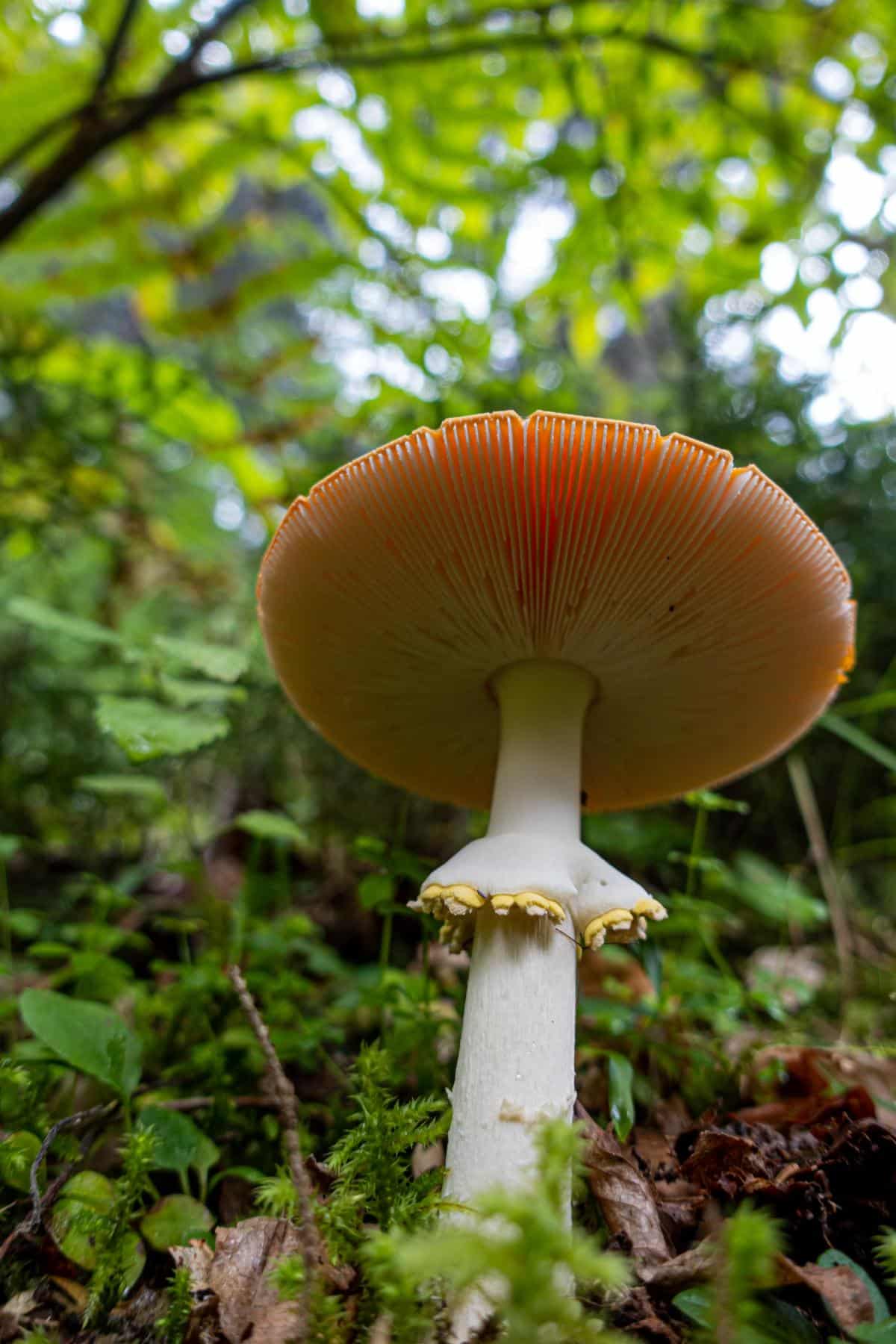
Jump to:
- The Difference Between Mushroom Rings and Mushroom Skirts
- How Mushroom Stem Rings And Skirts Form
- Common Mushroom Stem Rings and Skirts
- Importance of Stem Ring and Skirt Position
- Field Guide to Ring Textures
- Species Specific Mushroom Stem Rings and Skirts
- Frequently Asked Questions About Mushroom Skirts and Rings
The Difference Between Mushroom Rings and Mushroom Skirts
Both rings and skirts appear on the stem of the mushroom. They have the same origin (which we’ll get into later) but look quite different. A ring is pretty much what it sounds like – a visible ring around the upper portion of the stem. The skirt is also pretty self-explanatory. It is a hanging piece of mushroom flesh that is attached to the stem. It goes around the stem and may be super short or long and flowing.
A ring is usually just a mark, like a high tide mark or watermark in a bathtub. Or like someone circled the stem with a permanent marker. It may blend into the mushroom stem and be hard to make out clearly. This often depends on the age of the mushroom. Some are easier to see than others.
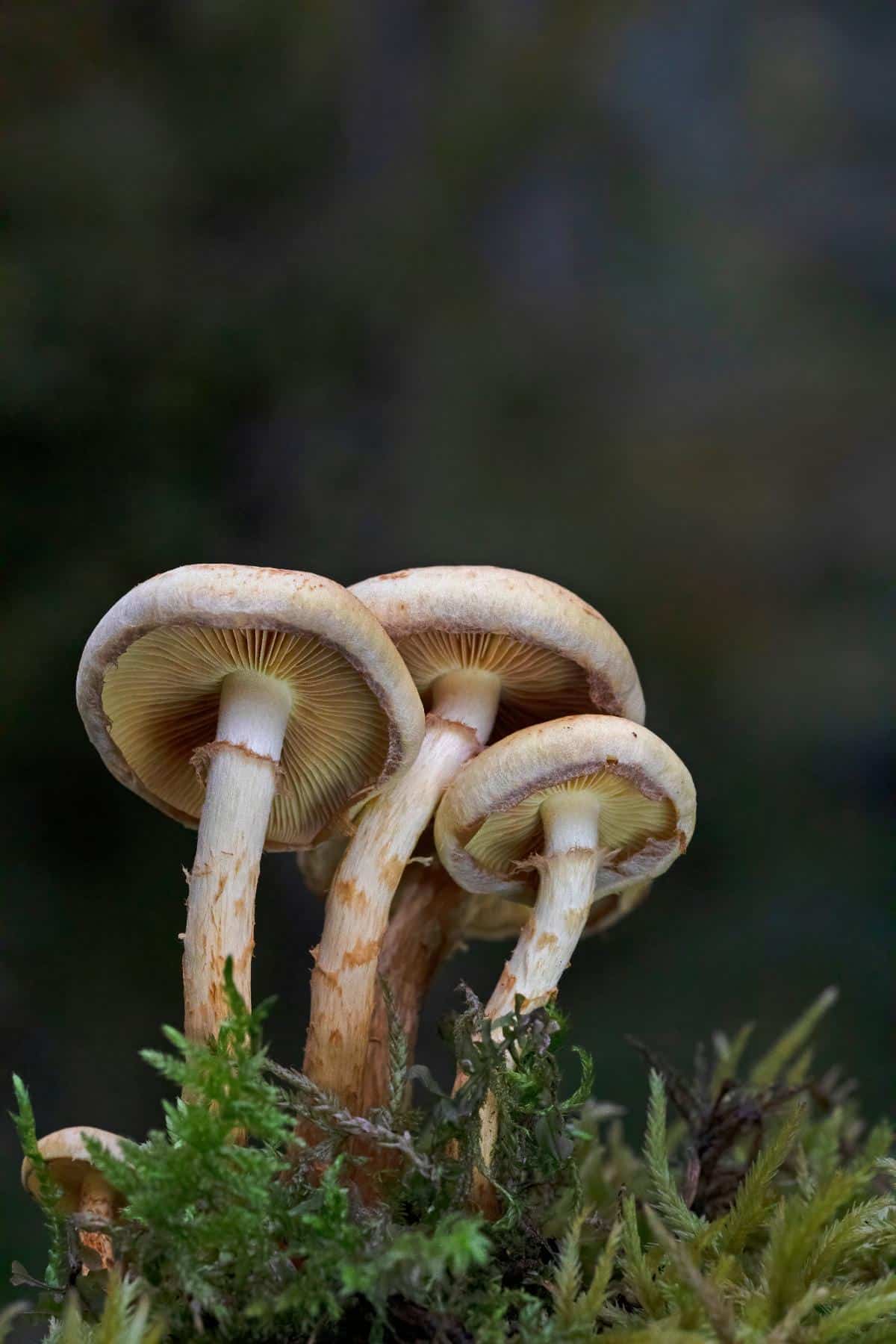
The mushroom skirt is a physical piece of the mushroom that encircles the upper stem. It is usually very noticeable, even when it is old and starting to disintegrate. It looks like the stem has a collar or band around it.
Some mushrooms start out with a skirt, and when it falls away, it leaves a ring marking around the stem where it once was. Other mushrooms only have a ring and never start with a distinctive skirt.
Stem rings and skirts both fall under the scientific name annulus, which is used as an umbrella term to cover all formations left behind on the stem by the partial veil. Annulus translates to “ring.” Many identification books and sources will use the term, annulus, instead of stem or ring. Usually, they will mark the presence or absence of one (which every good mushroom forager looks for on every mushroom!) but may not go into the details.
This is problematic because just the existence of one is not always enough to figure out the mushroom’s identification. There is actually quite a lot of variety in mushroom rings and skirts, and it’s worth investigating the different forms they take. Just noting whether one exists or not is often not enough to get a proper ID.

How Mushroom Stem Rings And Skirts Form
The mushroom’s ring starts forming at the very beginning of its growth stages. As the tiny knob-like mushroom growth comes up from the ground, the gills are covered by a protective membrane called a partial veil. It stretches from the stem to the cap’s edge and protects the developing gills.
It is called a partial veil because it only covers the underneath spore surface of the mushroom (a partial veil can form on mushrooms with gills and with pores). There is another type of mushroom covering, called a universal veil, that encapsulates the entire mushroom as it emerges from the ground. A mushroom might have just a partial veil, just a universal veil, or both.
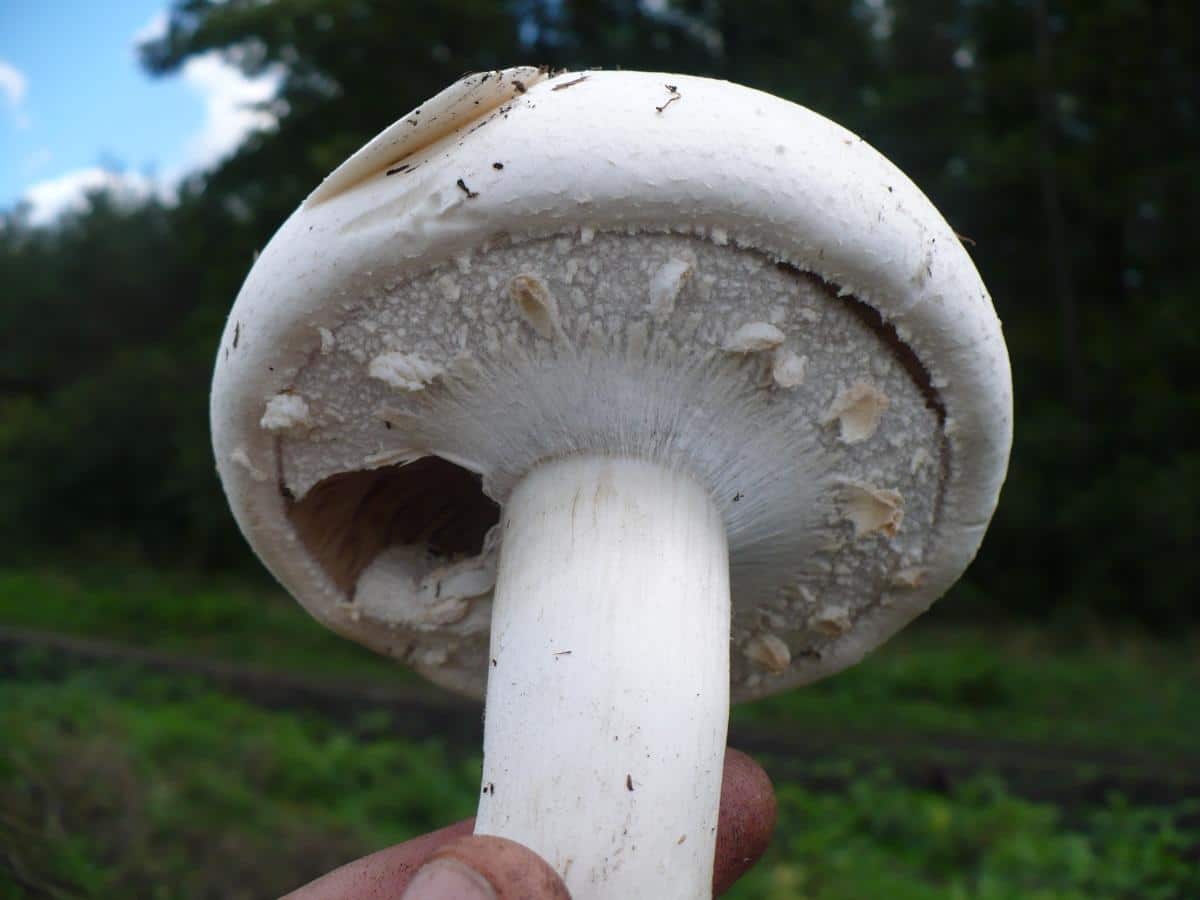
When it comes to the formation of rings and skirts around a mushroom’s stem, though, it is the partial veil that is important. A partial veil may be dense or fluffy or wispy, and therefore, the ring or skirt can also be dense, fluffy, or wispy.
When the mushroom is small and just emerging, the gills are covered by a fibrous material called the partial veil. Mushrooms can grow quite quickly, sometimes doubling in size every 24 hours. As the mushroom grows, the expanding cap and stem create tension, stretching the partial veil as it goes.
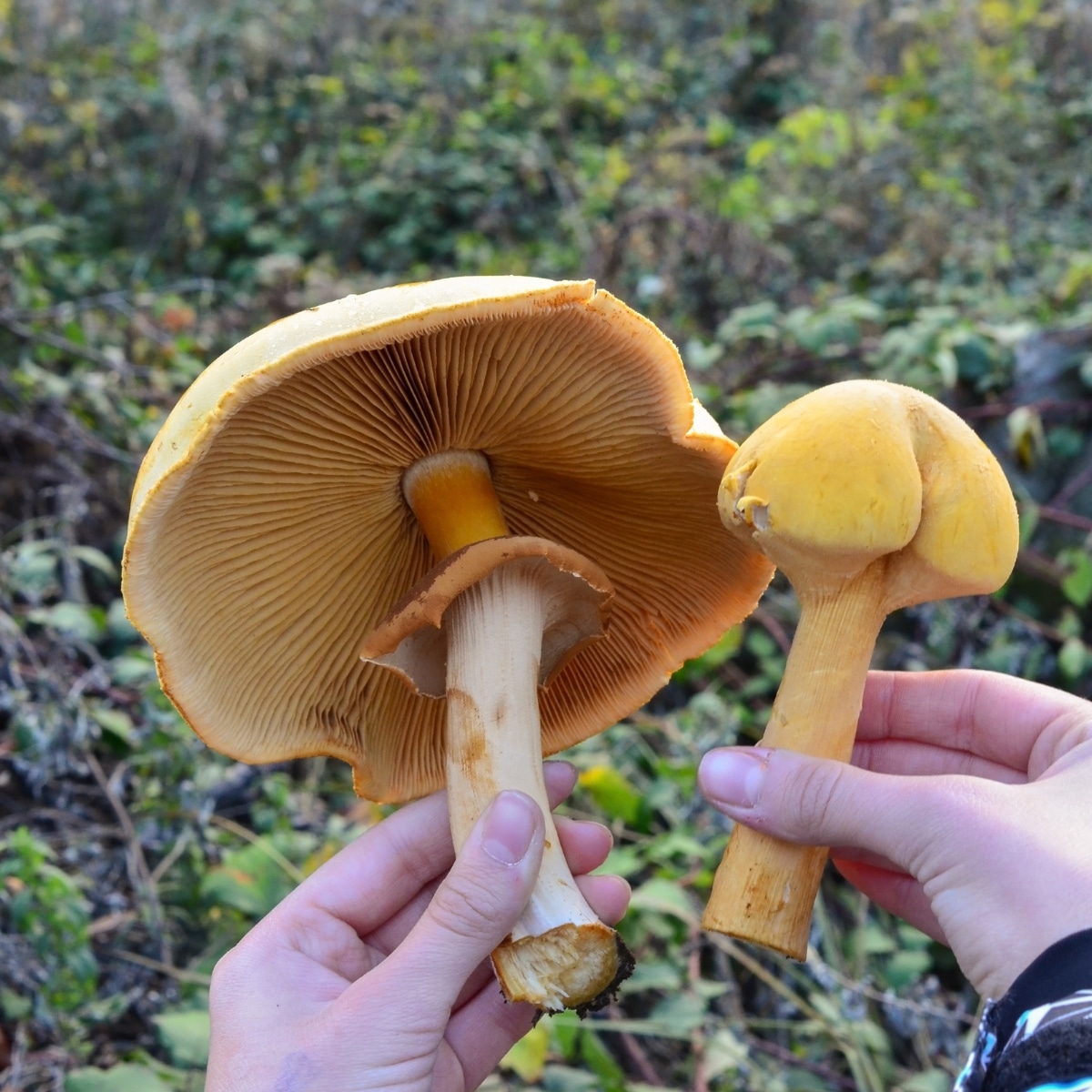
Eventually, the veil stretches so much it breaks. As it breaks, the fibers tear and are left hanging where they’re most strongly attached. In most cases, this is around the upper stem – the point of strongest attachment. It’s also not uncommon to see partial veil remnants hanging from the edge of the cap, too.
The broken veil leaves a skirt or ring-like structure called the annulus around the stem. These skirts and rings vary in shape, size, color, and durability. Some are like thin skin, while others are cottony with fibers that pull apart easily. The rings and skirts might be slimy or fluffy and dry. This is why knowing and understanding ring and skirt structures is such an important part of mushroom identification. They can vary so much!
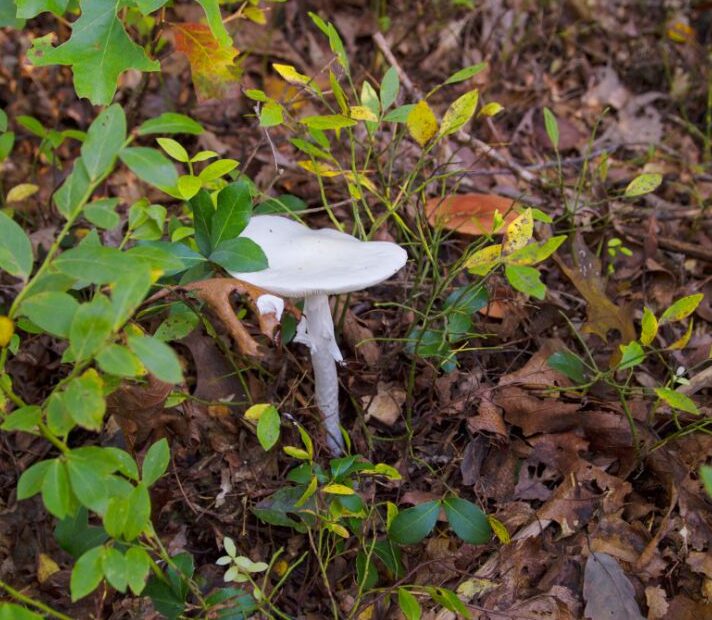
Common Mushroom Stem Rings and Skirts
The veil remnants create a variety of ring and skirt-like formations. Each formation has distinct characteristics that help tell different species apart.
It’s important to note that a mushroom’s ring or skirt doesn’t always stay the same throughout its lifetime. The more delicate rings might completely disappear soon after the veil breaks and leave just a faint ring zone on the stem. These are often called fleeting, ephemeral, evanescent, transient, or impermanent.
The rings can peel off the stem, fall apart, or fade into the stem as it grows. Rings may also be fragile, easily torn, or damaged as the mushroom matures and faces the elements. Some rings last throughout the mushroom’s life,
When you’re trying to identify a mushroom, it’s always helpful (if possible) to collect several specimens in different stages of growth. This way, if it has a ring that disappears with age, you can see it on the younger specimens.
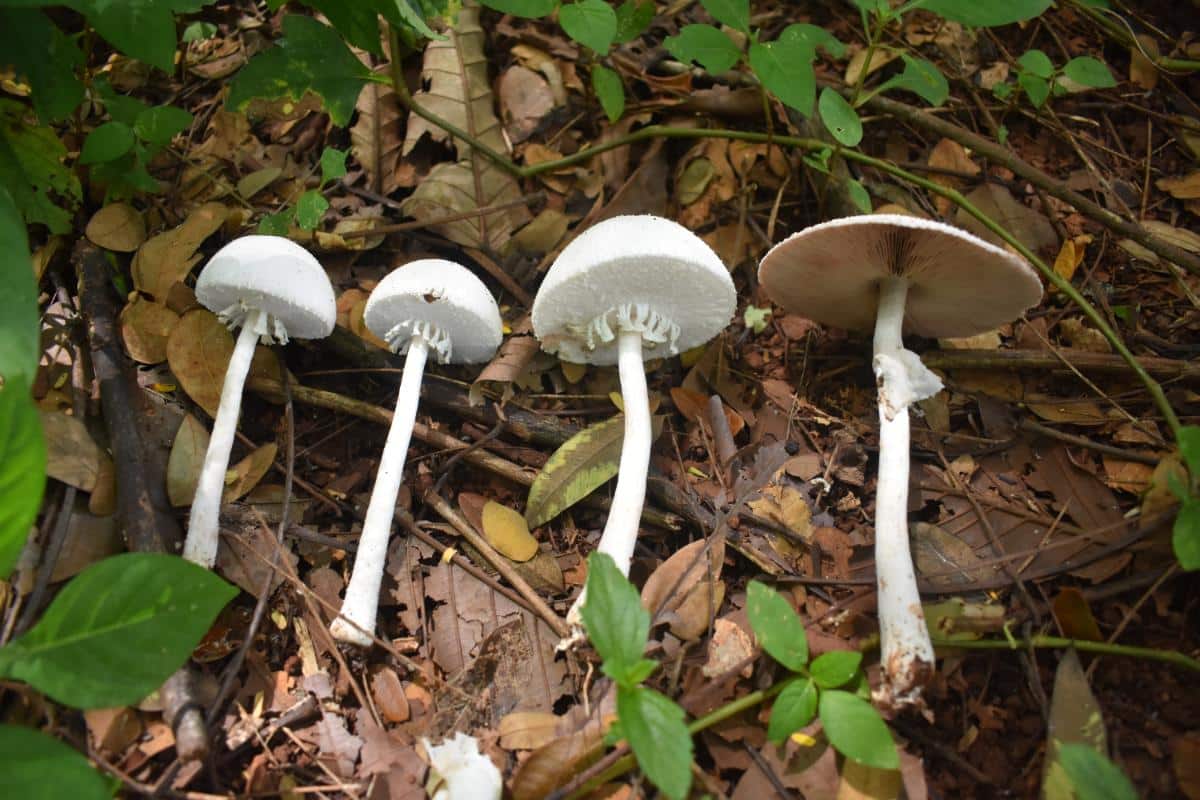
Ring Zone
Ring zones are areas on the stem where traces of the partial veil stay behind but are barely or not at all visible to start out. In these cases, the mushroom’s spores drop down from the gills onto the ring zone and discolor it. This is what makes it visible. Sometimes, the ring zone is extremely noticeable and distinctive because it’s a different color than the stem. But that’s not always the case. The ring might also be very light, and you need to look closely to see it.


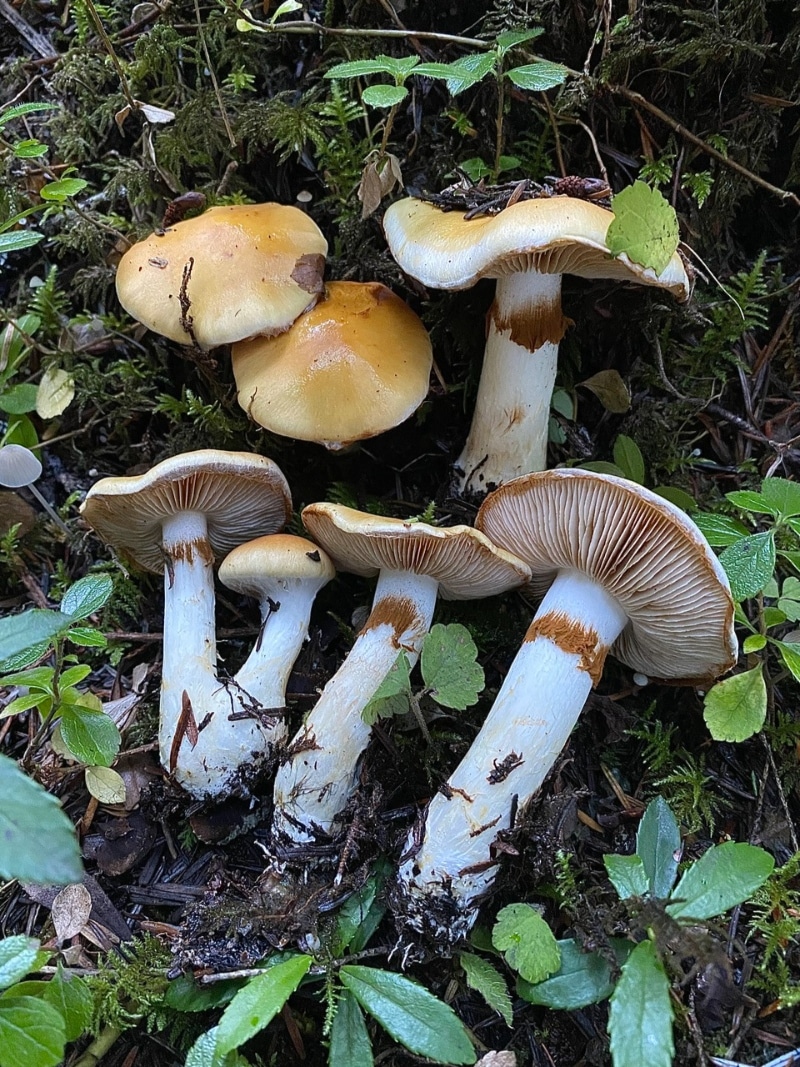
Simple Ring
This is a thin band of mushroom flesh around the stem. It is the place where the partial veil was attached to the stem. When the veil broke, the fragments were left behind. It looks like someone put a ring on the mushroom stem (who’s out there marrying mushrooms?!). The band might be thin or thick and it varies in texture and color.

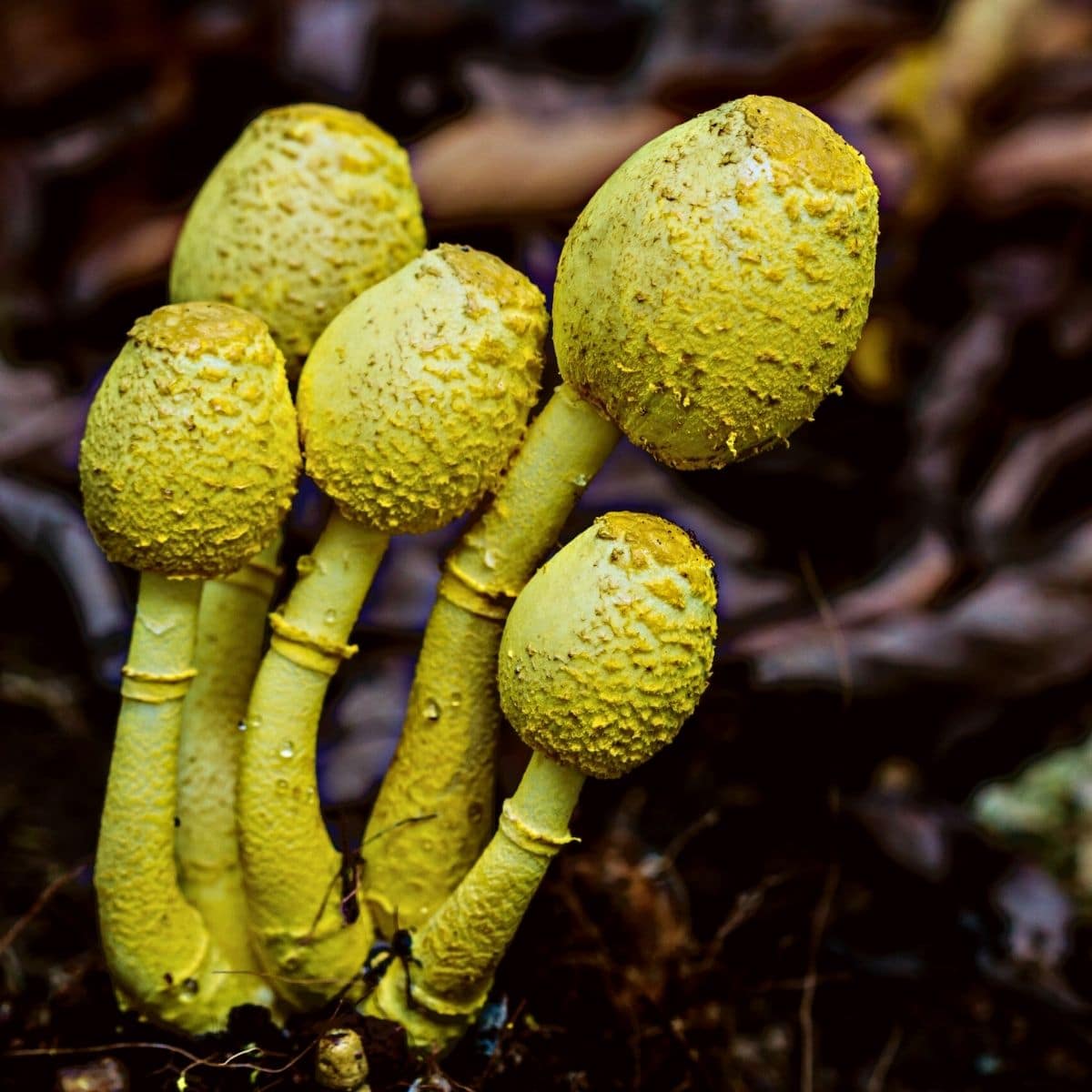
Pendant Skirt
A pendant skirt hangs downward from the stem and looks like a delicate curtain-like flap. Or, a flowing skirt. Pendant skirts tend to really stand out and are quite pretty. The destroying angel mushroom is a perfect example of this pendant formation. It has a prominent white hanging skirt around the upper stem. Pendant skirts vary in length. Some are more like a mini-skirt, while others are longer and flowing.
Pay attention to the length as well as the texture and thickness. Some are thin and fragile, while others are thick and hardy. They can also be slightly fuzzy or totally smooth.
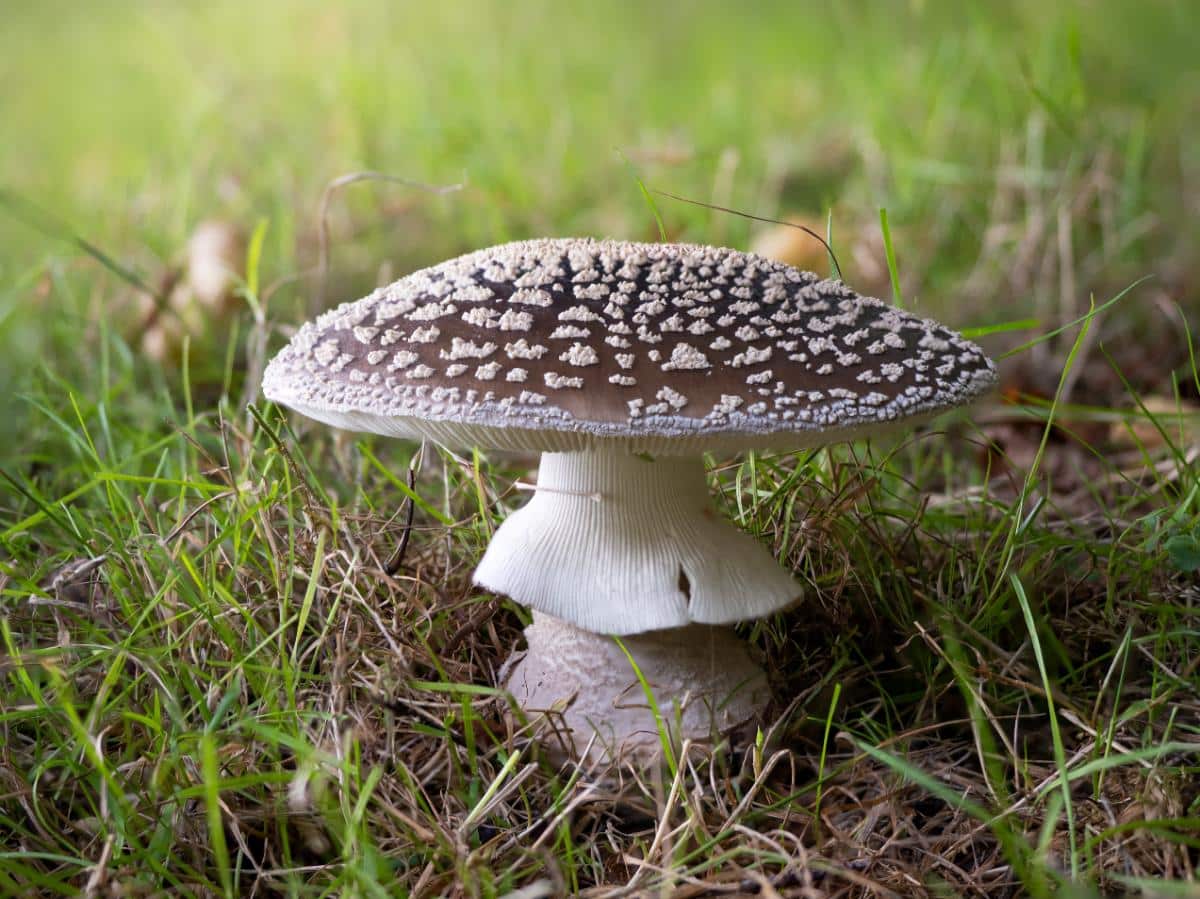
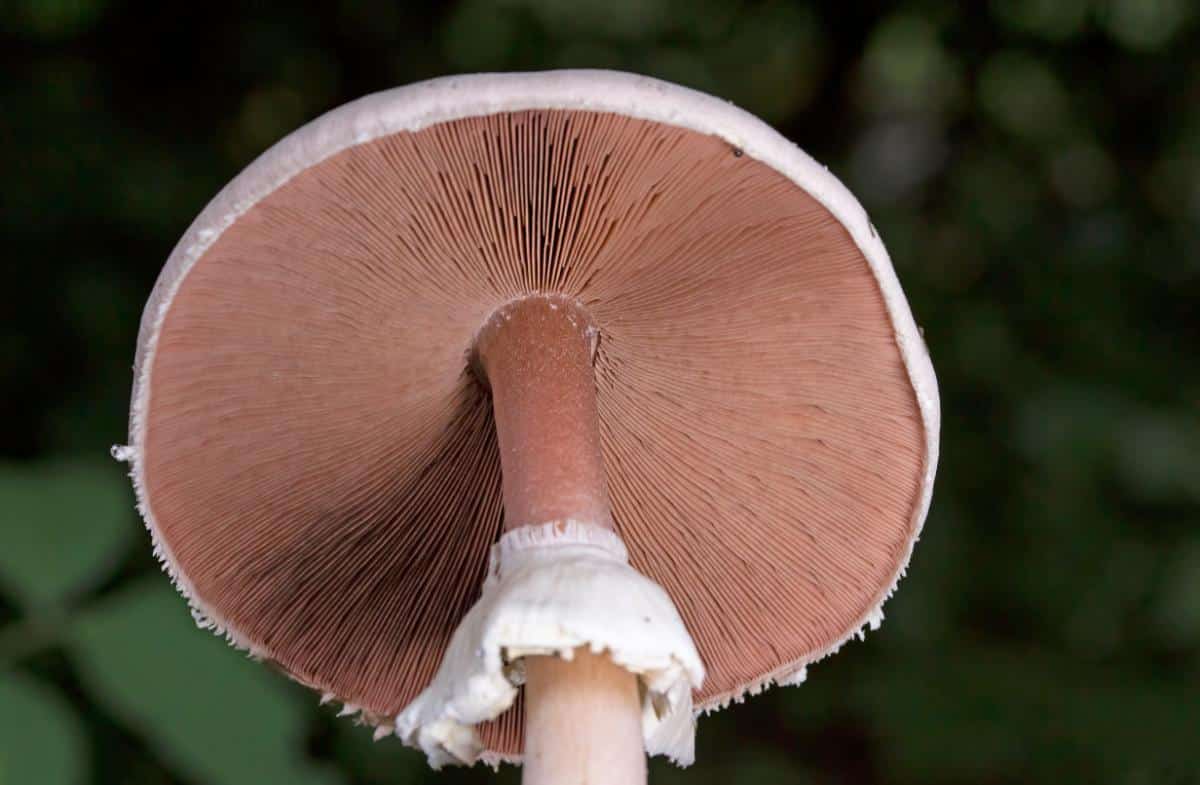
Flaring Skirt
Flaring skirts extend upward and away from the stem. They look like an umbrella capsized by strong winds. Or a skirt that has been flipped up in the breeze. This type of skirt is less common than the pendant style, so its presence makes a big difference in identification as it narrows down the options quite a lot.
The golden bootleg mushroom is a classic example of this type of skirt.
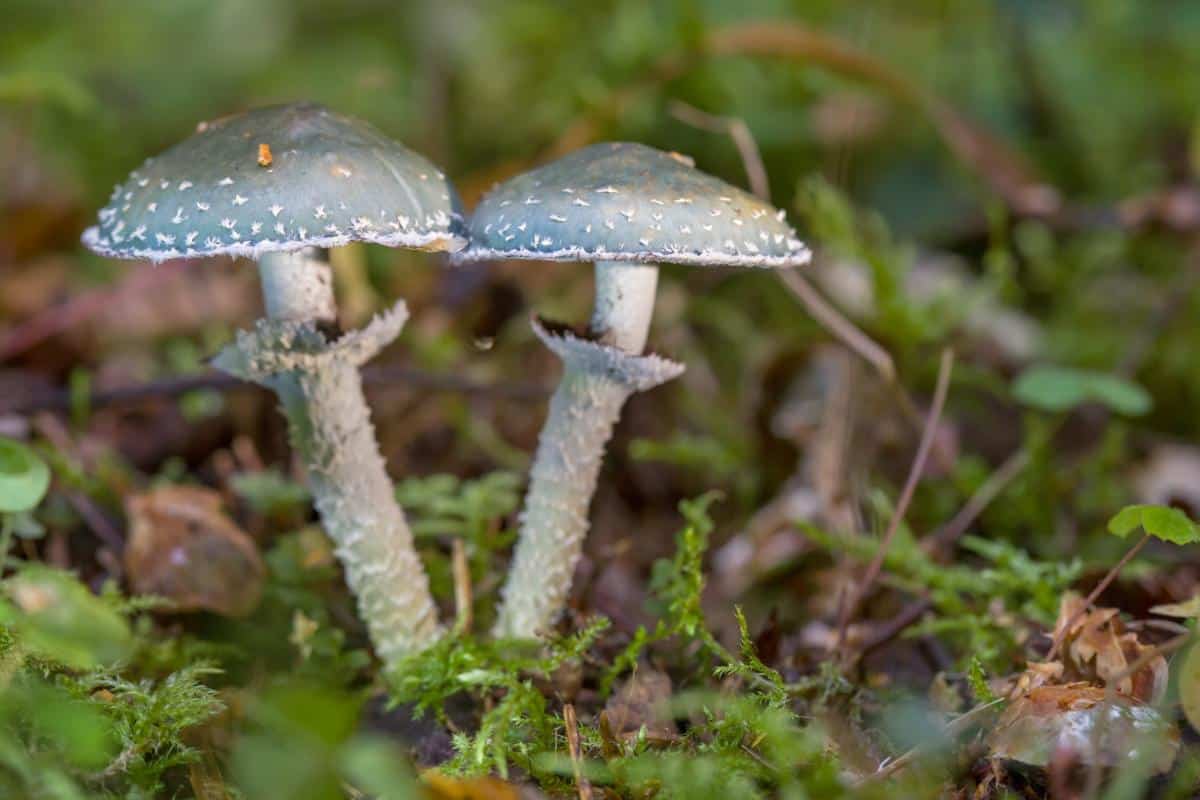
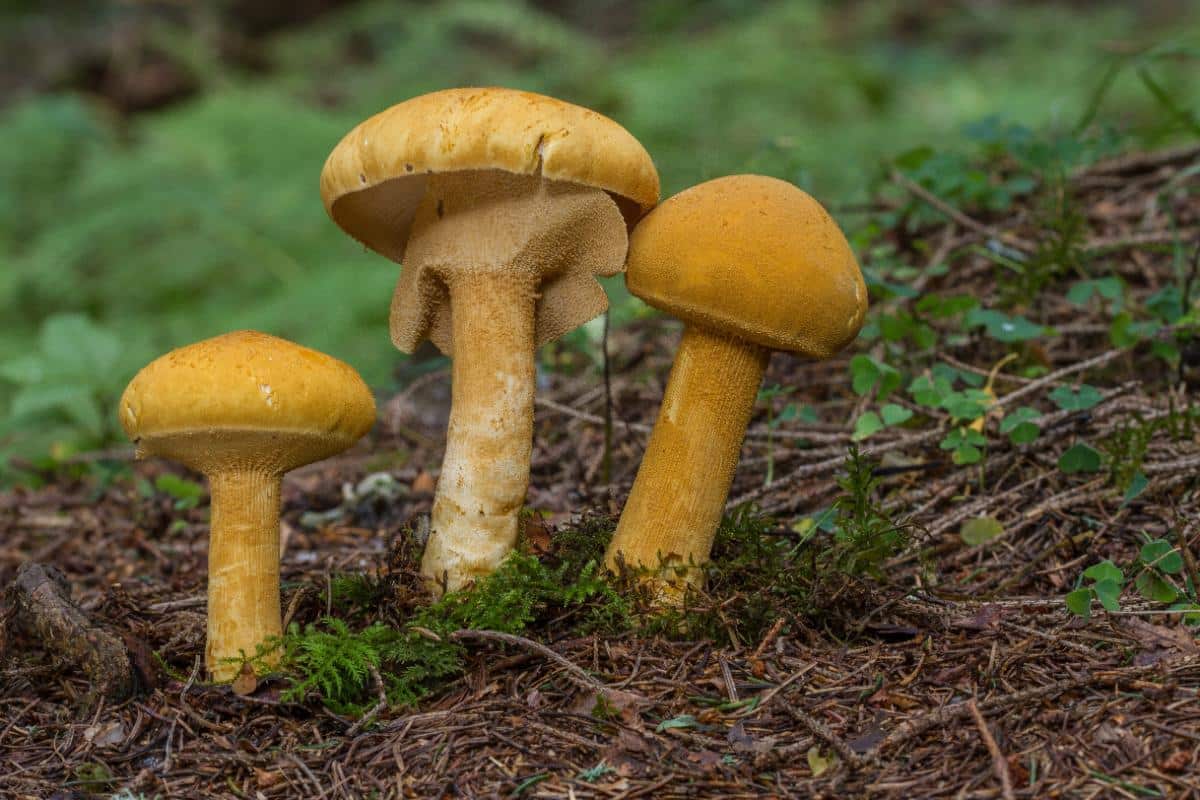
Double Ring or Skirt
A double skirt is exactly what it sounds like. Instead of having one hanging pendant skirt around the stem, the mushroom has two. This is also a less common attribute and will greatly narrow down the identification field.
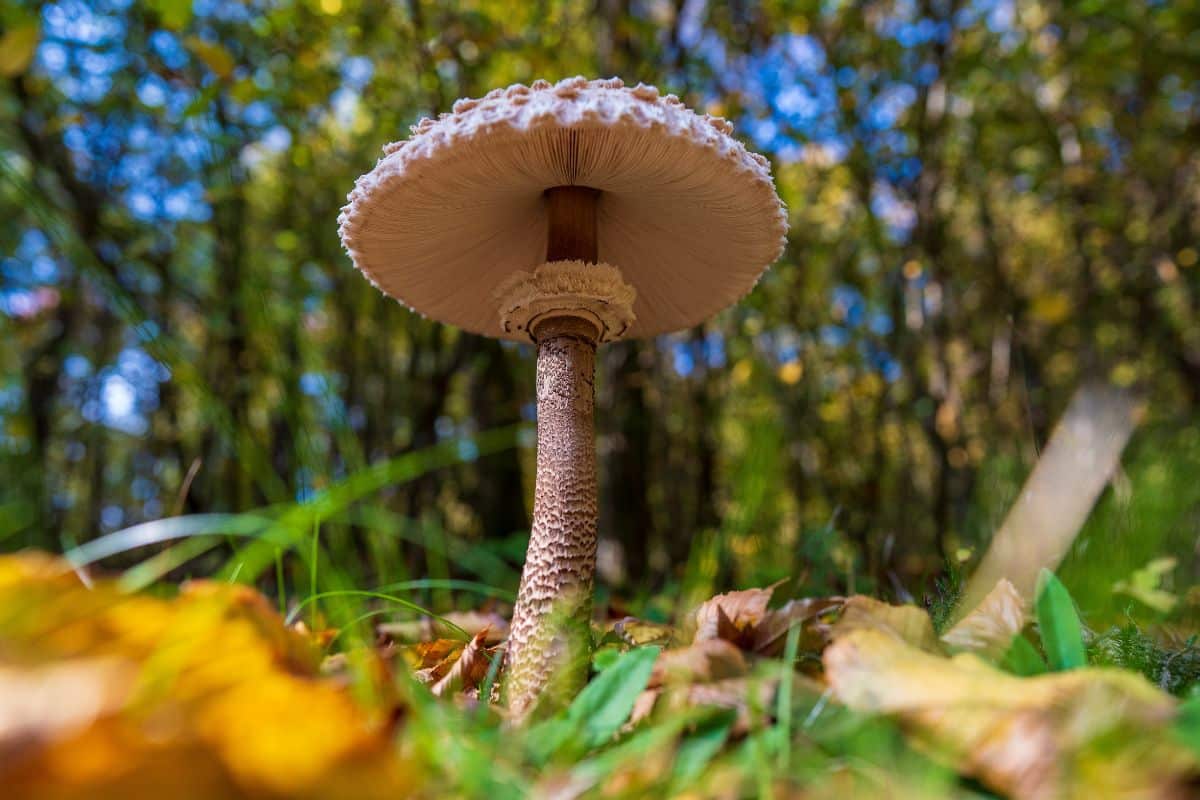
Stellate
This type of stem ring has a star-shaped or cogwheel-like appearance. The stellate ring has radiating points or tooth-like projections that extend outward in a pattern resembling a star or gear.
The star-like pattern of the ring is more pronounced on younger mushrooms. However, as the mushrooms age, these points fade and become less noticeable. The ring wears down over time, which is frustrating for the person trying to identify the mushroom! This is a good reason to try to collect several specimens of each species for identification. Often, you need to see the younger mushrooms side by side with the mature ones to figure out what’s going on.
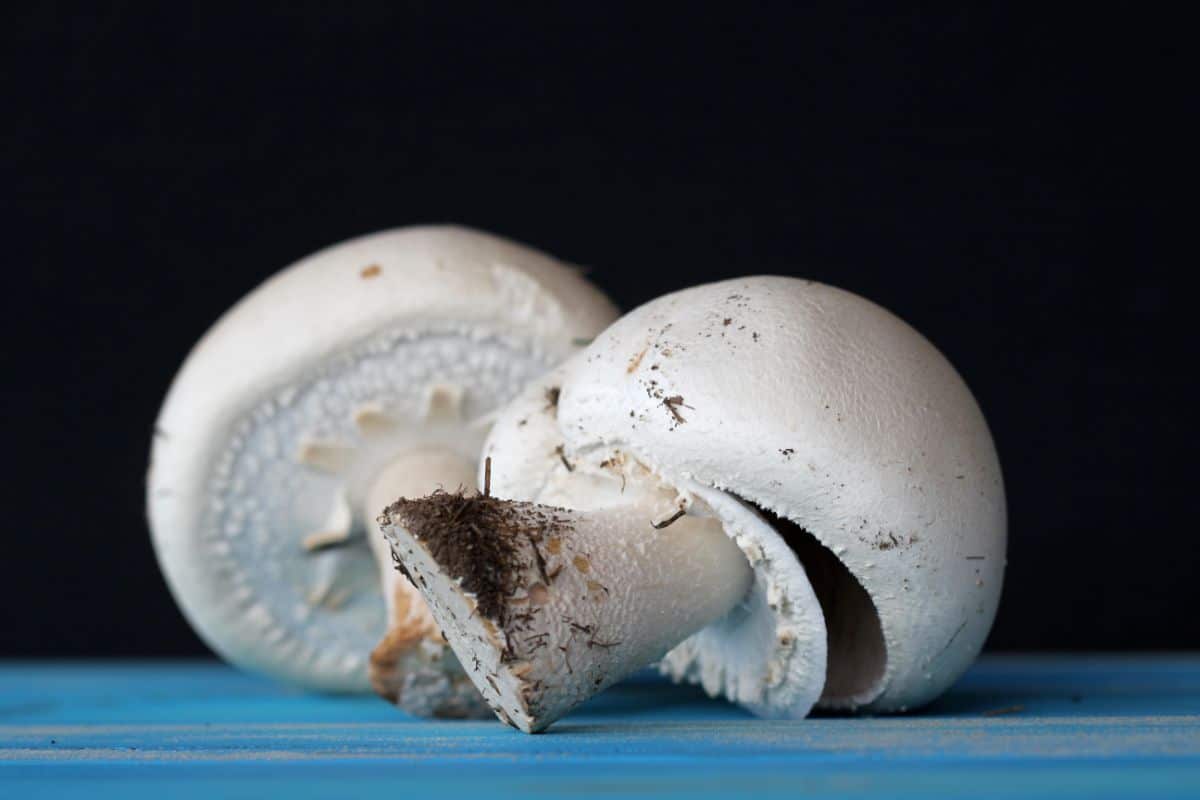
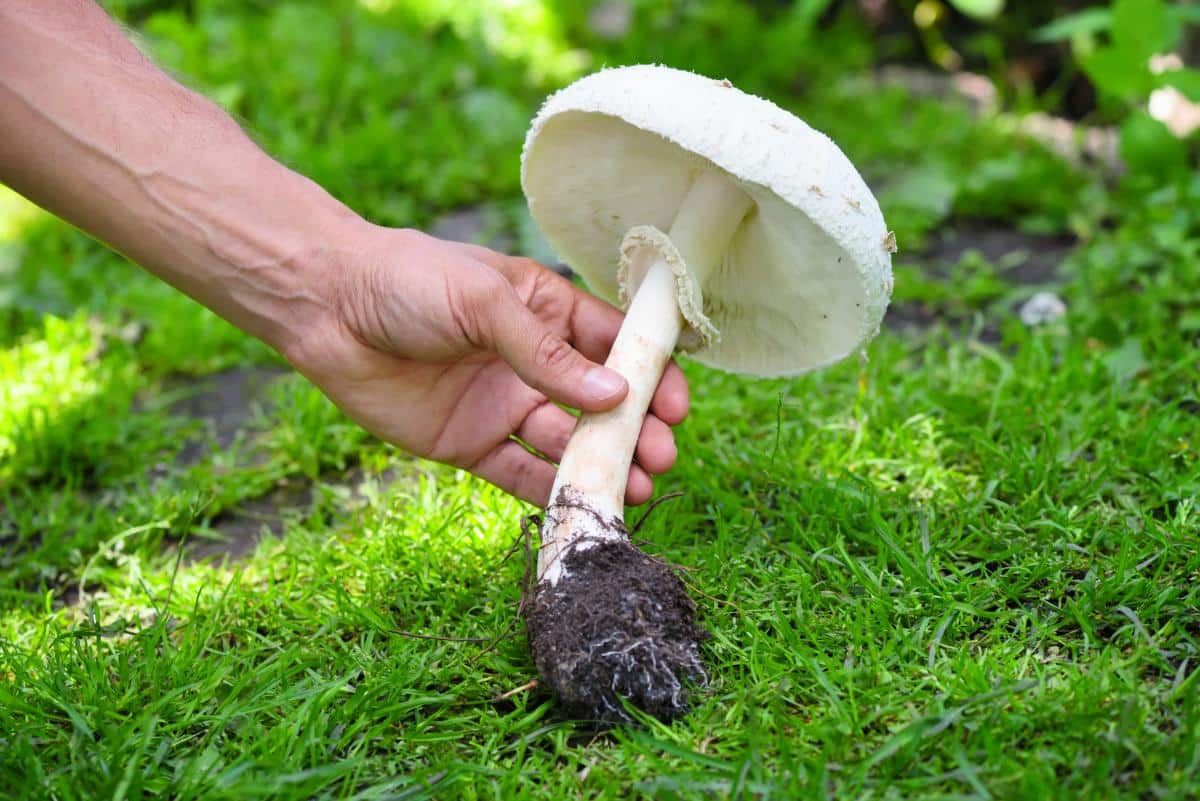
Peronate Boot
A peronate formation is a thin layer of mushroom skin that envelops the entire stem like a protective boot. This happens with mushrooms that had a universal veil in youth, not a partial veil.
A peronate sheath gives the mushroom a particularly elegant appearance. This characteristic is not common, and its existence helps a lot with identification.
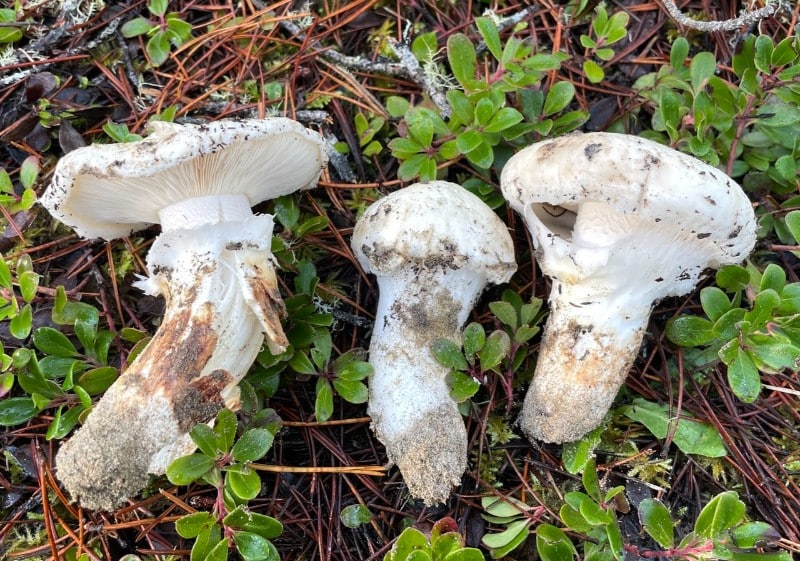
Importance of Stem Ring and Skirt Position
A lot can be determined from where the skirt or ring is located on the stem. Most often, the ring or skirt is around the upper part of the stem, but not always. And, it can vary based on stem height and mushroom age.
Some rings stay firmly in place, while others can slide up and down the stem. Whenever you come across a mushroom with a ring or skirt, check to see if it can be easily moved up and down the stem.
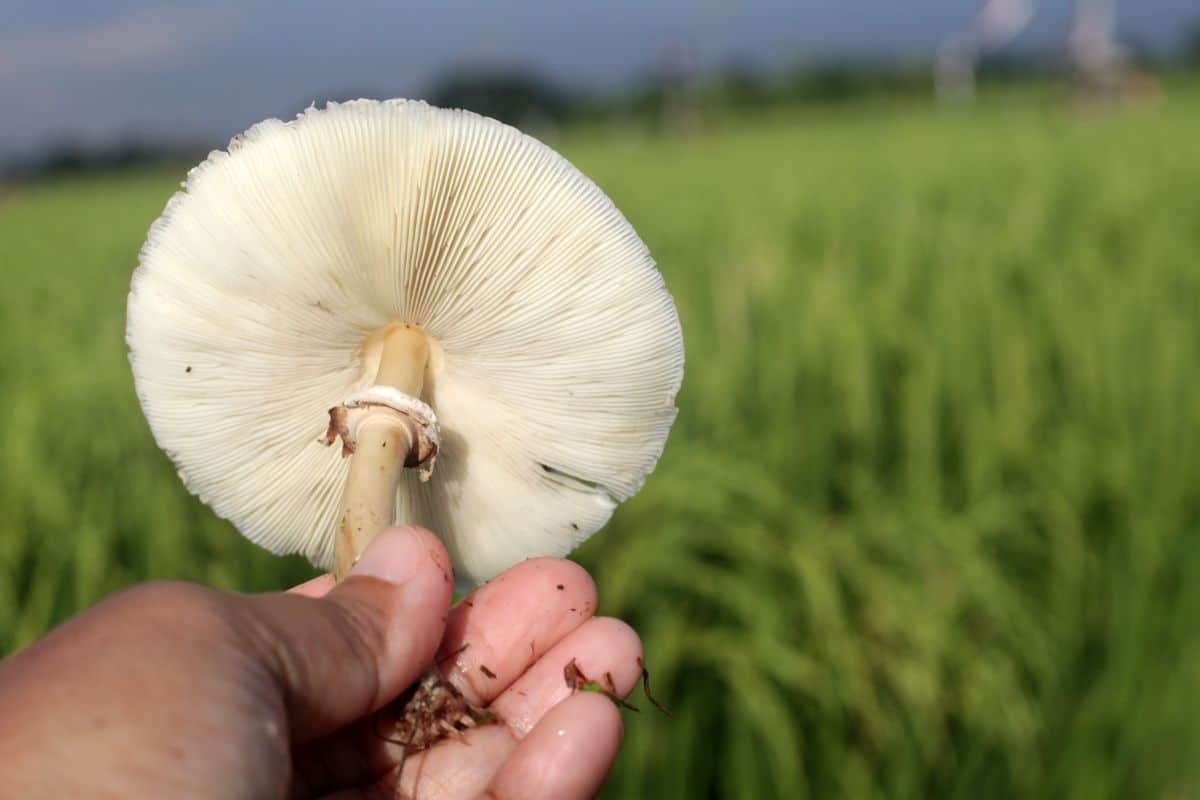
Another essential part of ring and skirt placement is that it may act as a border between stem colors. In many cases, the color of the mushroom’s stem is a different color above the ring than below the ring. The texture of the stem may also be different above the ring or skirt than the texture below it.
Here’s what to look for when identifying rings and skirts:
- Persistence – Some rings and stems are there the mushroom’s whole life, while others fade with age, deteriorate, or fall off.
- Mobility – Some rings stay fixed in place while others move freely up and down the stem.
- Texture – The texture might be membranous, wooly, dense, slimy, or fragile.
- Position – The ring or skirt might be around the upper, middle, or lower part of the stem.
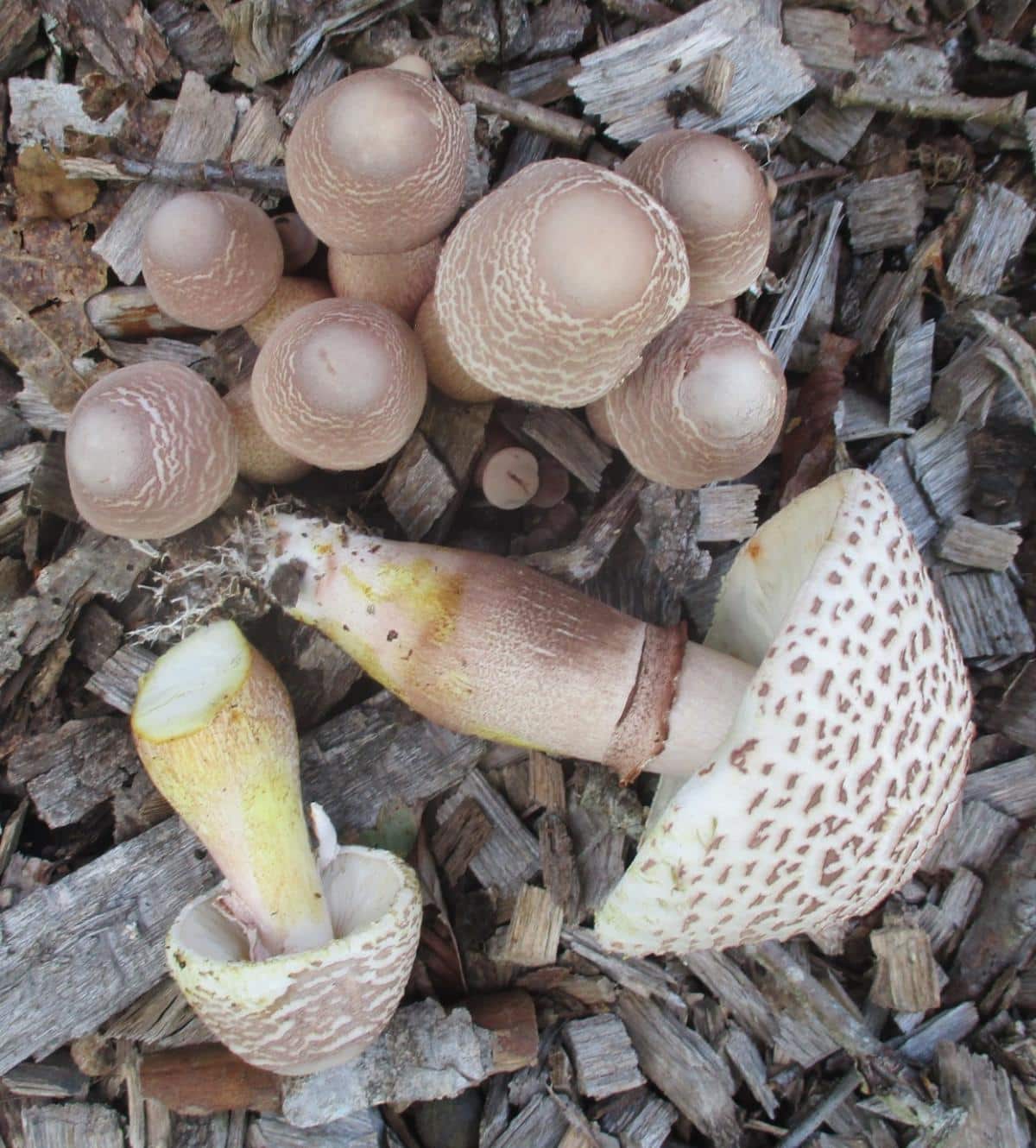
Field Guide to Ring Textures
The texture of the ring or skirt is a big part of determining the species. Textures range quite a bit among different types of mushrooms. The texture of the ring often determines how long it will last. Tough membranous skirts and rings are usually stronger and last longer. Fragile cortina-type rings might only leave light traces or colored fibers on the stem.
Membranous
Membranous rings are thin and tear easily. As the name suggests, they are made up of very thin fibers that are like cobwebs. This type of ring often falls off or deteriorates quickly. Sometimes, parts of the membranous ring stay attached to the edge of the cap and hang down in small pieces. Gymnopilus junonius, the big laughing gym, is an example of this. Its ring is fibrous and delicate, but it tends to remain on the stem for a long time.
Most mushrooms with this type of veil have it break off easily and then hang down from the cap and/or stem in bits and pieces. When they are fully mature, the veil is often completely gone (washed away, fallen off, or just deteriorated). They do usually leave behind a ring zone, though, as evidence it once existed.
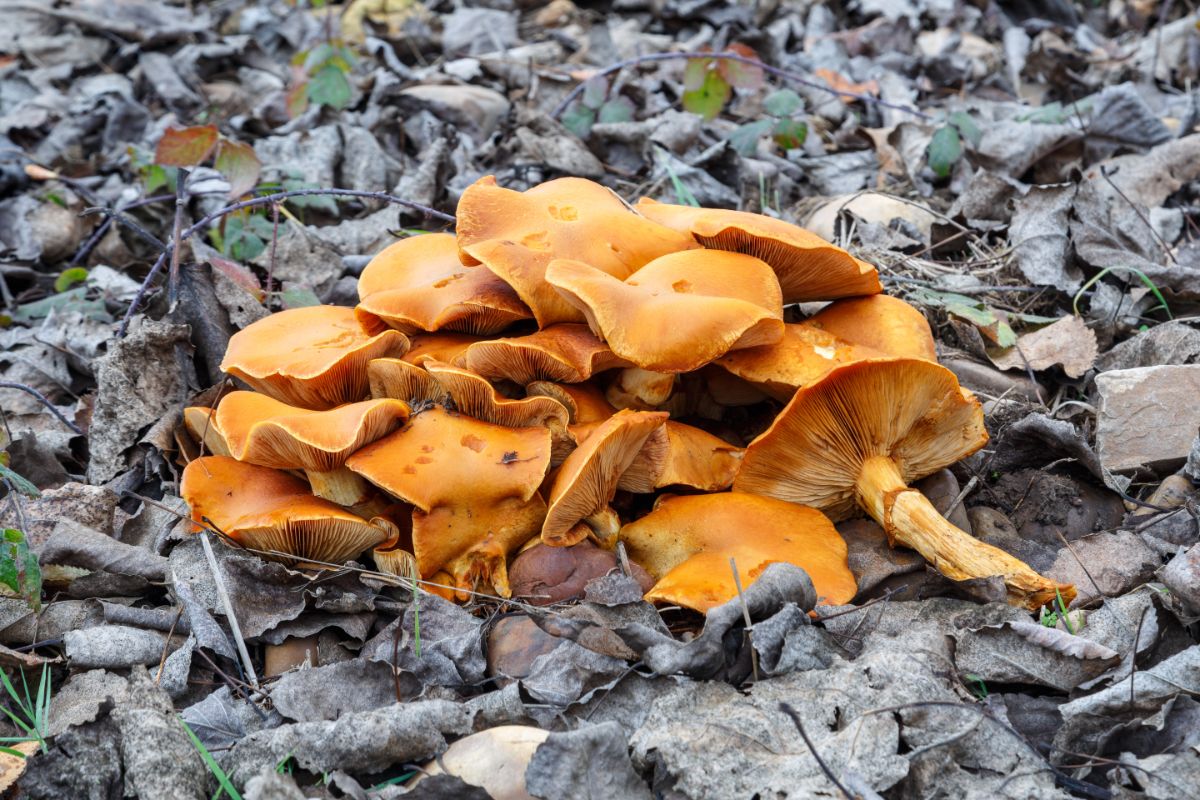

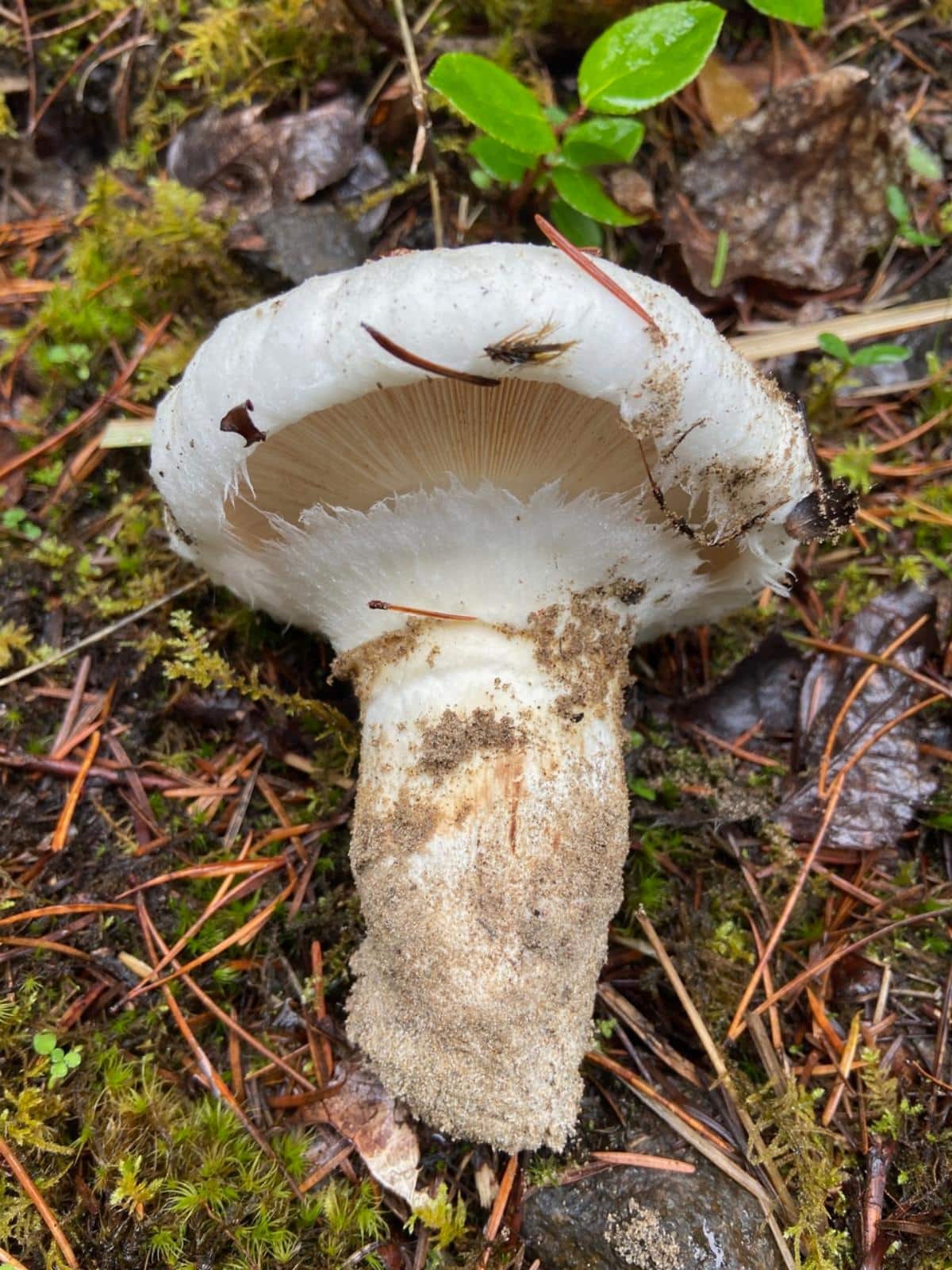
Delicate
Delicate stem skirts are different from membranous because even though they are fragile to the touch, they usually remain intact on the stem for most of the mushrooms lifespan. They may break or start to fall apart, but they don’t disappear completely. Delicate skirts are usually pendant-like and flowing. Most Amanita species have delicate yet intricate and long-lasting stem skirts.
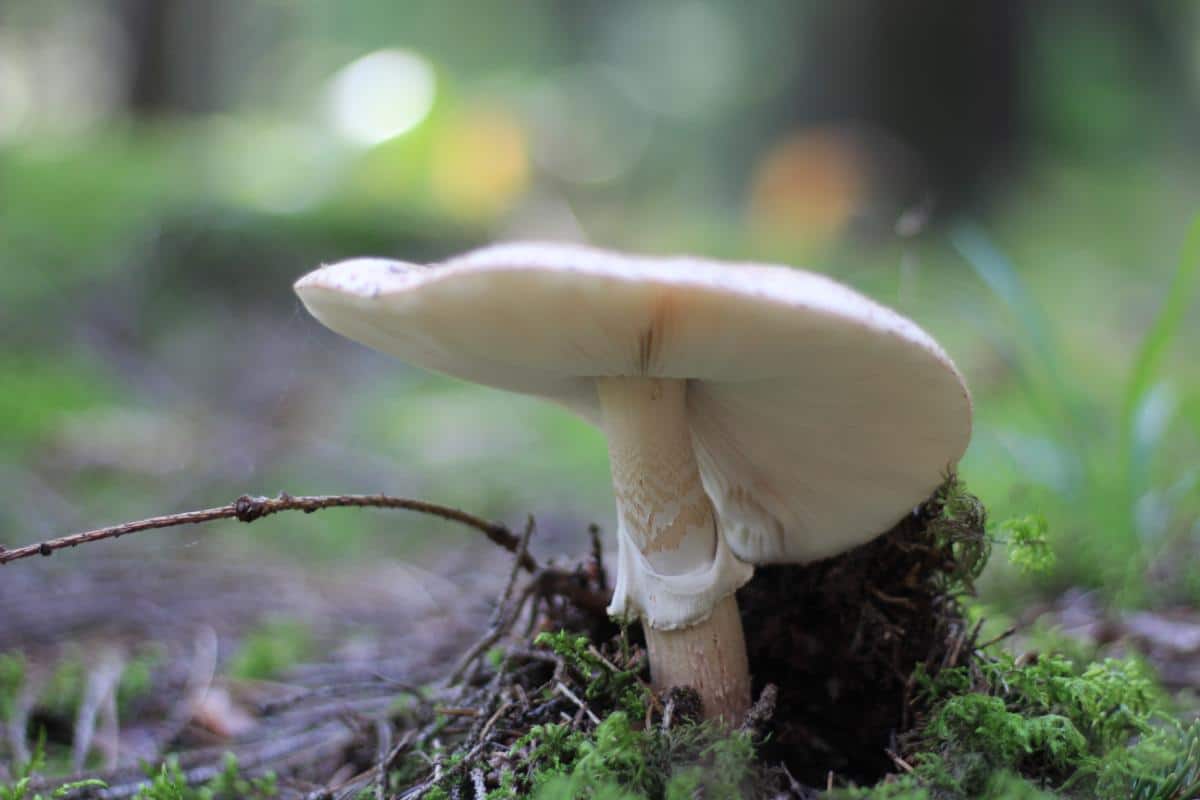
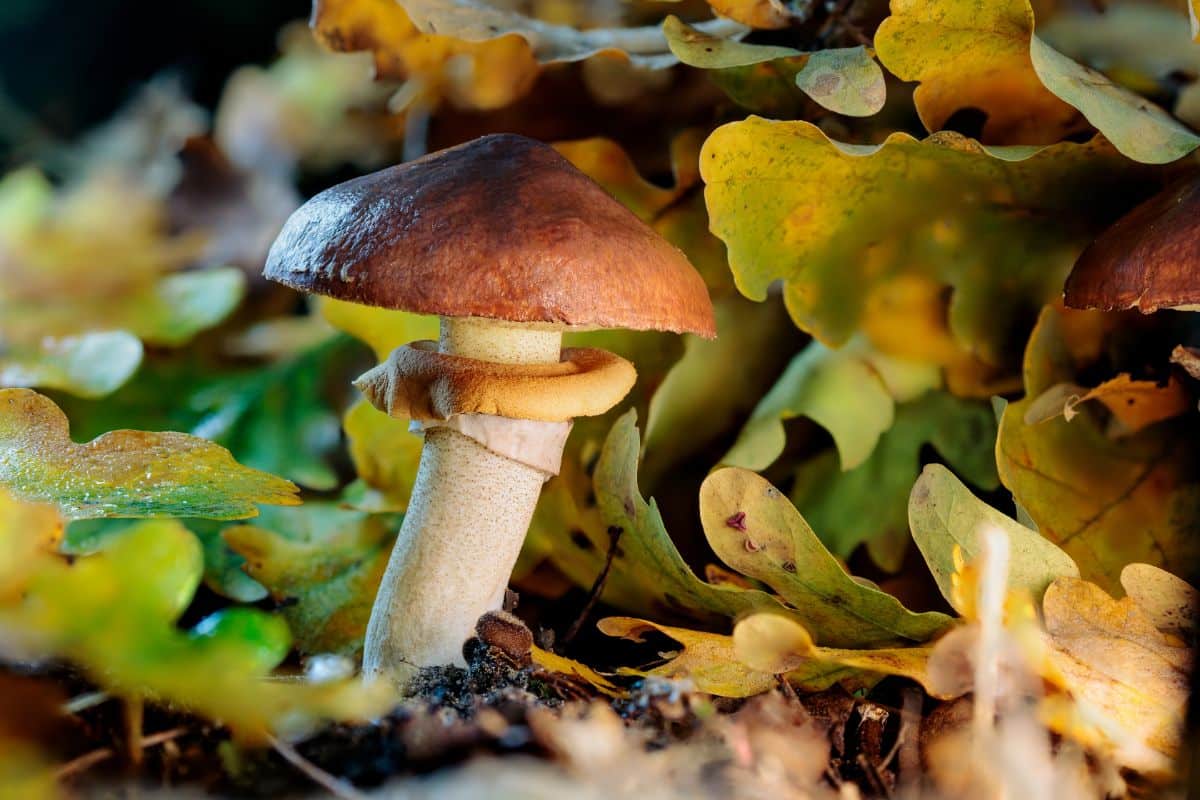
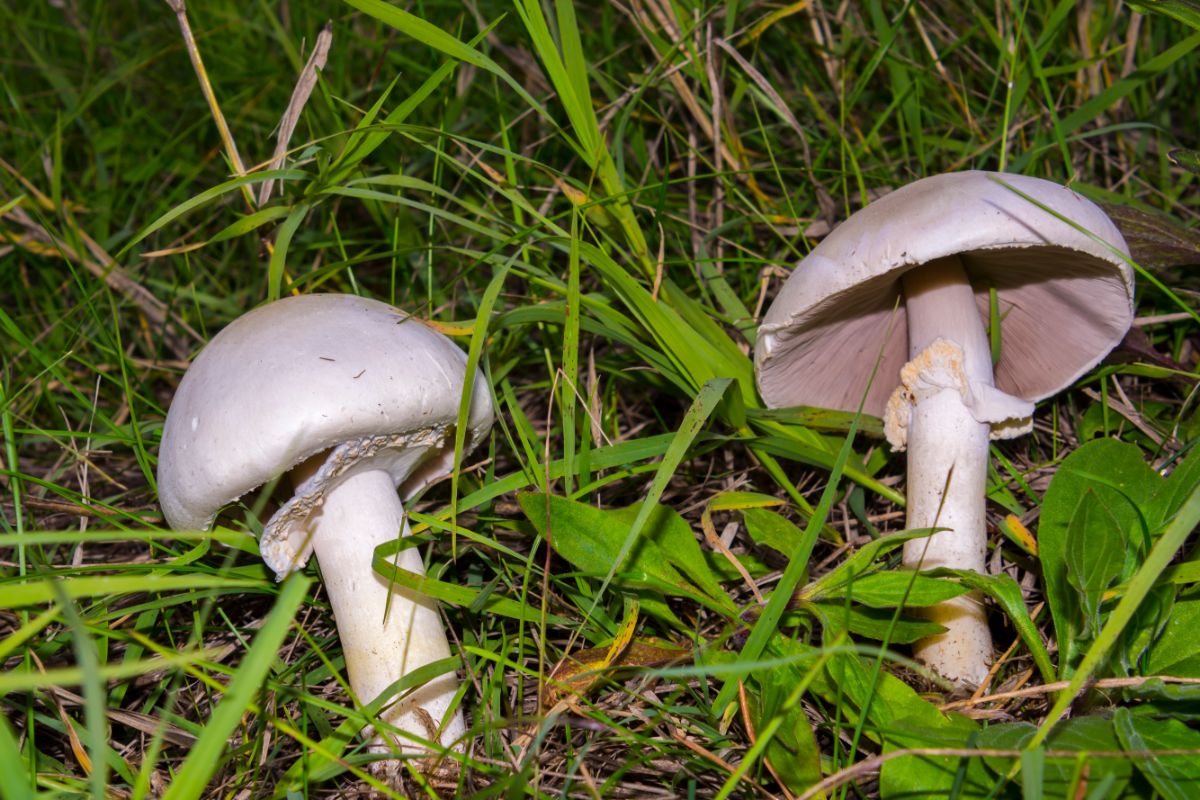
Wooly
Wooly rings are hairy and tufted. They usually match some scaly or fibrous patterns on the surface of the cap. These rings usually have:
- Fibers that feel like cotton balls
- Clear top and bottom parts
- Thin strands that make up fibrillose structures
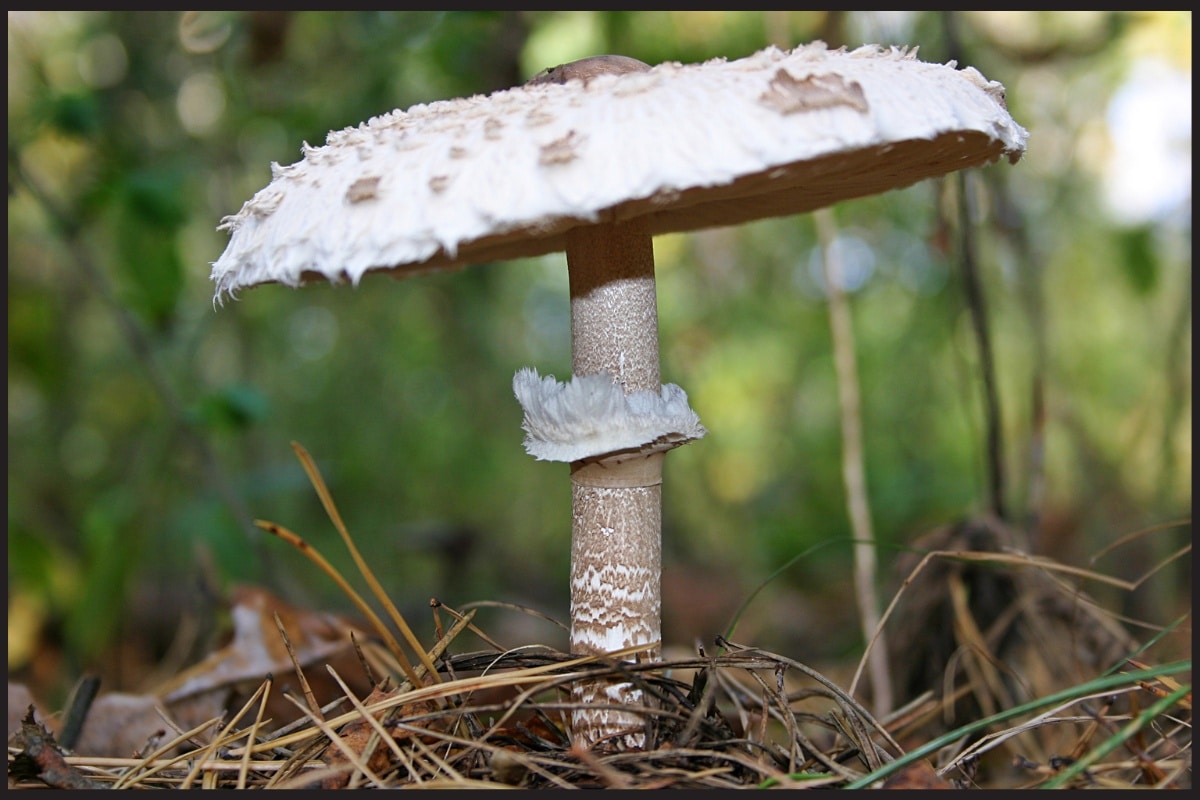
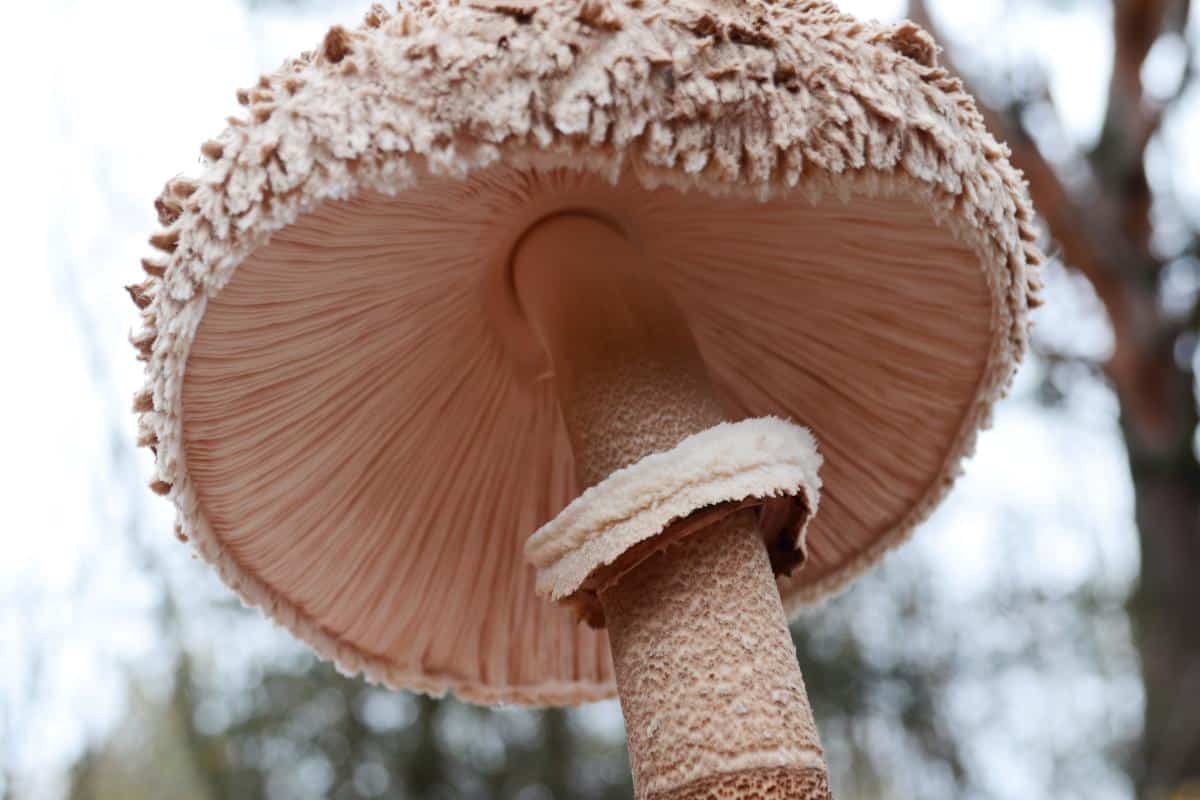
Tough
Some mushrooms, like Armillaria mellea, the honey mushroom, have thick, dense stem rings and skirts that remain firmly in place throughout the mushrooms’ lifespan. If weather conditions are particularly rough, they may deteriorate but there is usually always still something left around the stem.
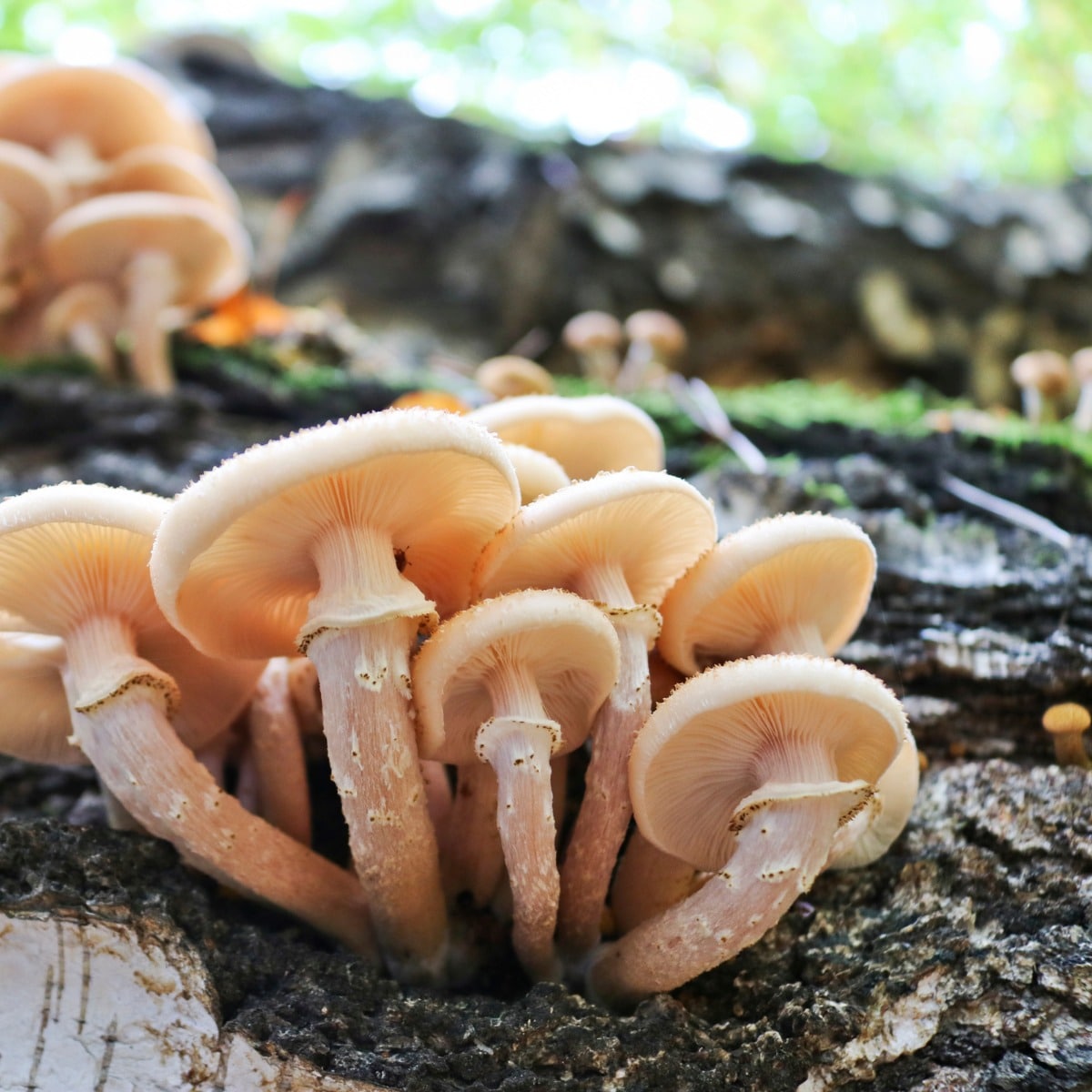
Cortina
This ring texture is most well-known among the aptly named Cortinarius species. In young specimens, the cobweb-like partial veil stretches from the cap edge to the stem. It is extremely thin, like silk, and forms an intricate network of fine, gossamer threads. The cortina filaments are translucent and fragile yet are firm enough to protect the developing gills and spore surface.
As the mushroom matures, the cortina collapses around the stem and forms a ring. It may look like scattered fibers on the upper stem or a light or dark band of color.
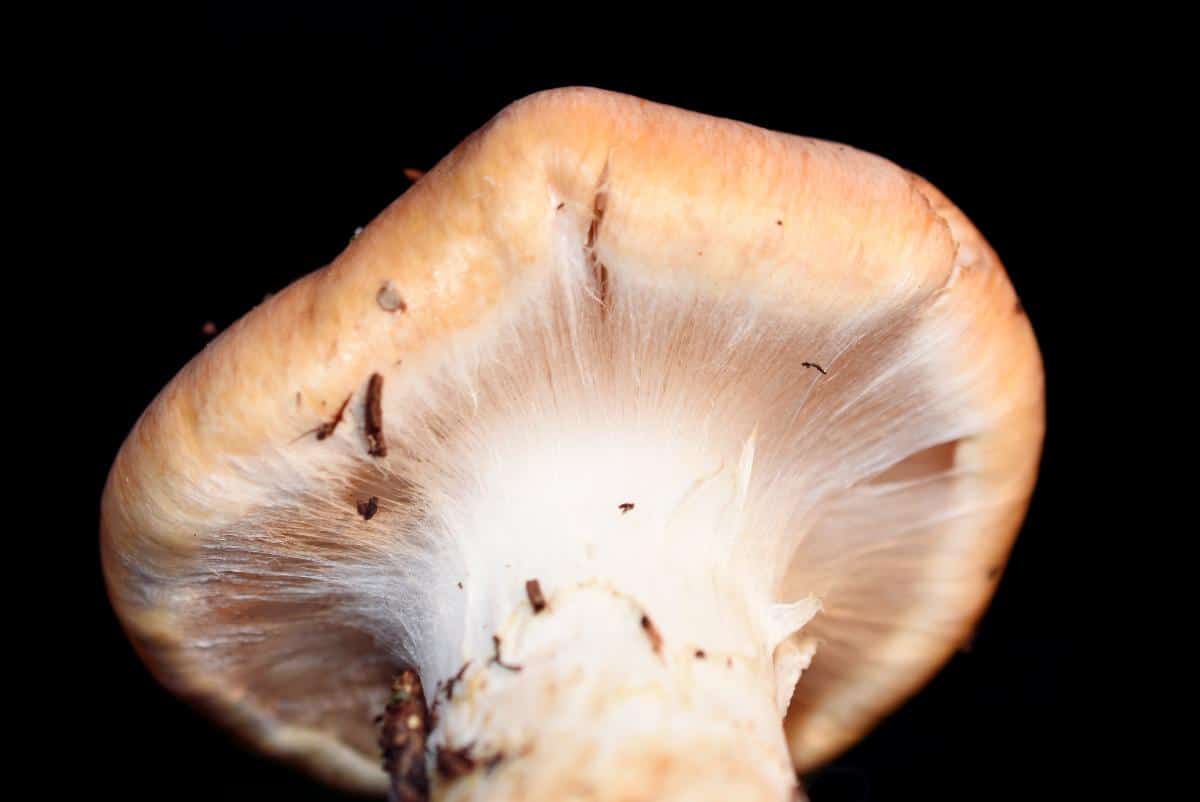
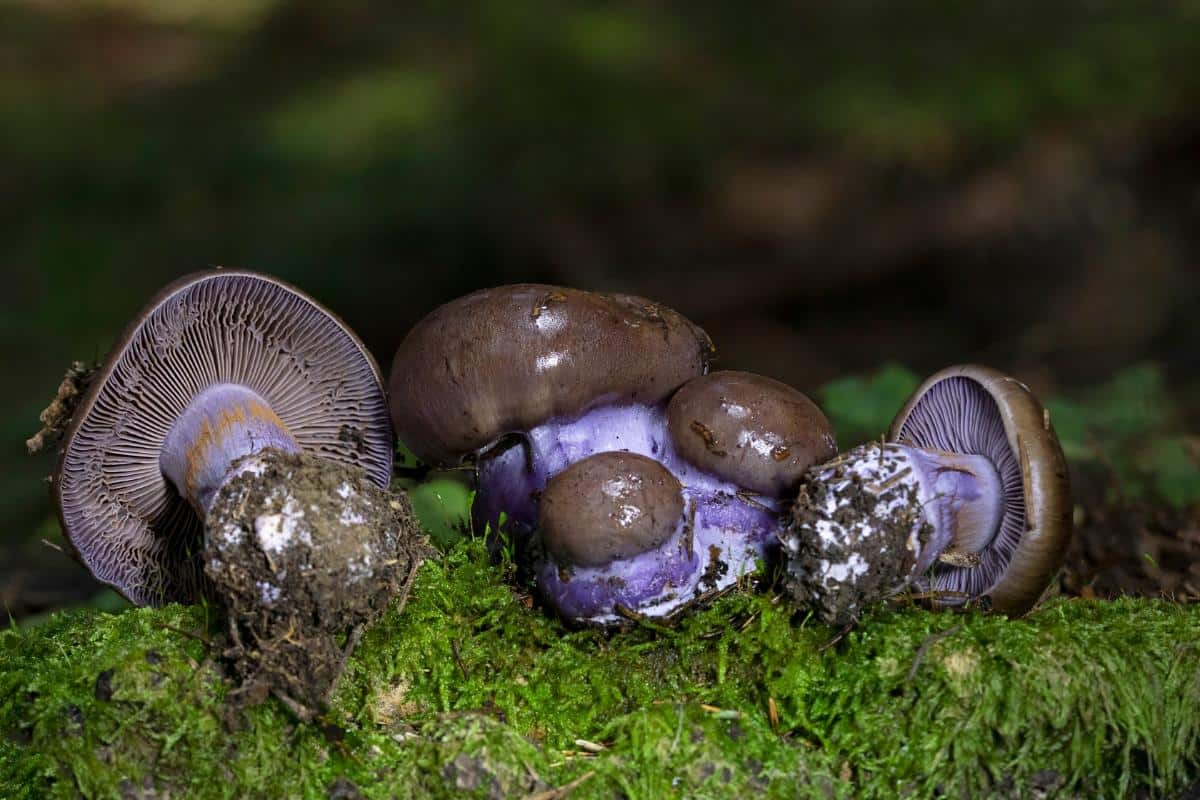
Species Specific Mushroom Stem Rings and Skirts
Mushroom stem rings and skirts vary across families and species. Some mushroom families develop similar-looking or specific types of rings and skirts. So, usually, the stem or ring formation can be used to at least identify the family the mushroom comes from, even if it isn’t enough for a specific identification.
Amanita Mushrooms
The Amanita very often has distinct ring features. The majority of members in this group have a noticeable ring just below the cap and have white spore prints. These two things combined help put them in the Amanita family. Several well-known and dangerous mushrooms are part of this family and showcase these characteristic traits. The destroying angels (A. bisporigera, A. ocreata) have a noticeable white ring around their upper stem. The death cap (A. phalloides) has a similar ring around its stem.
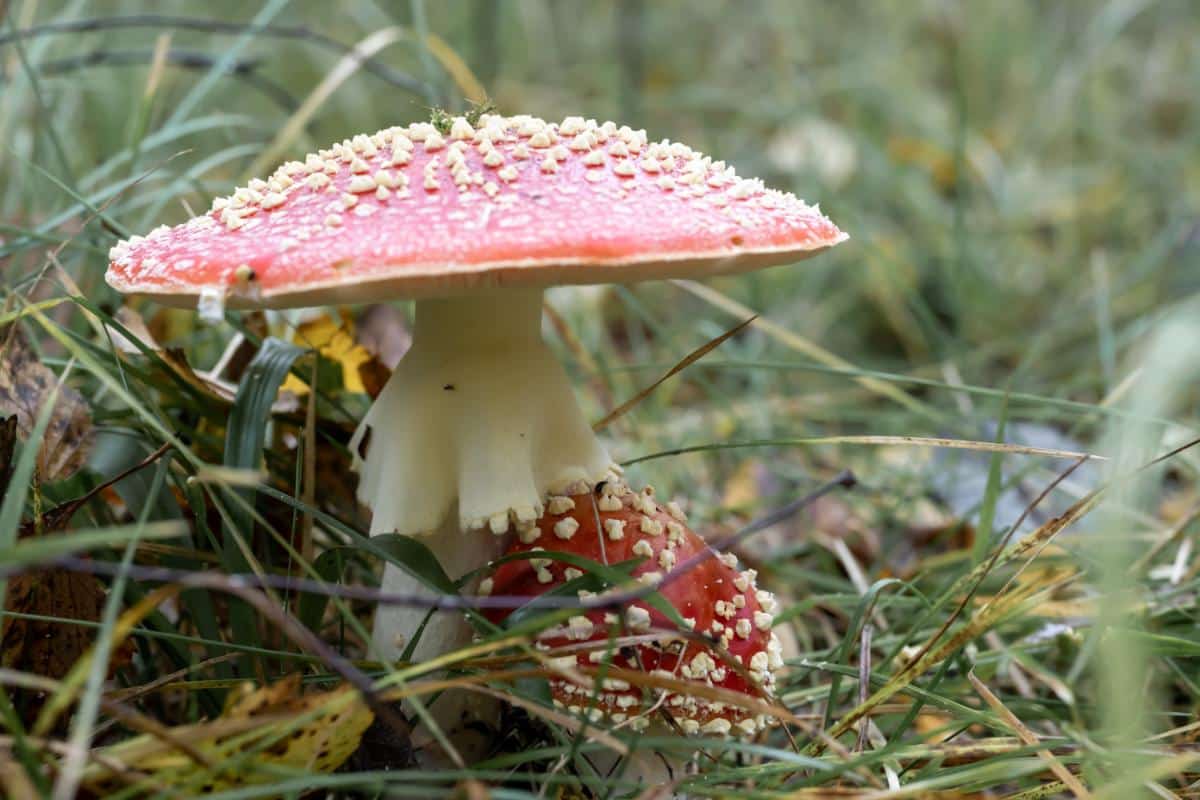
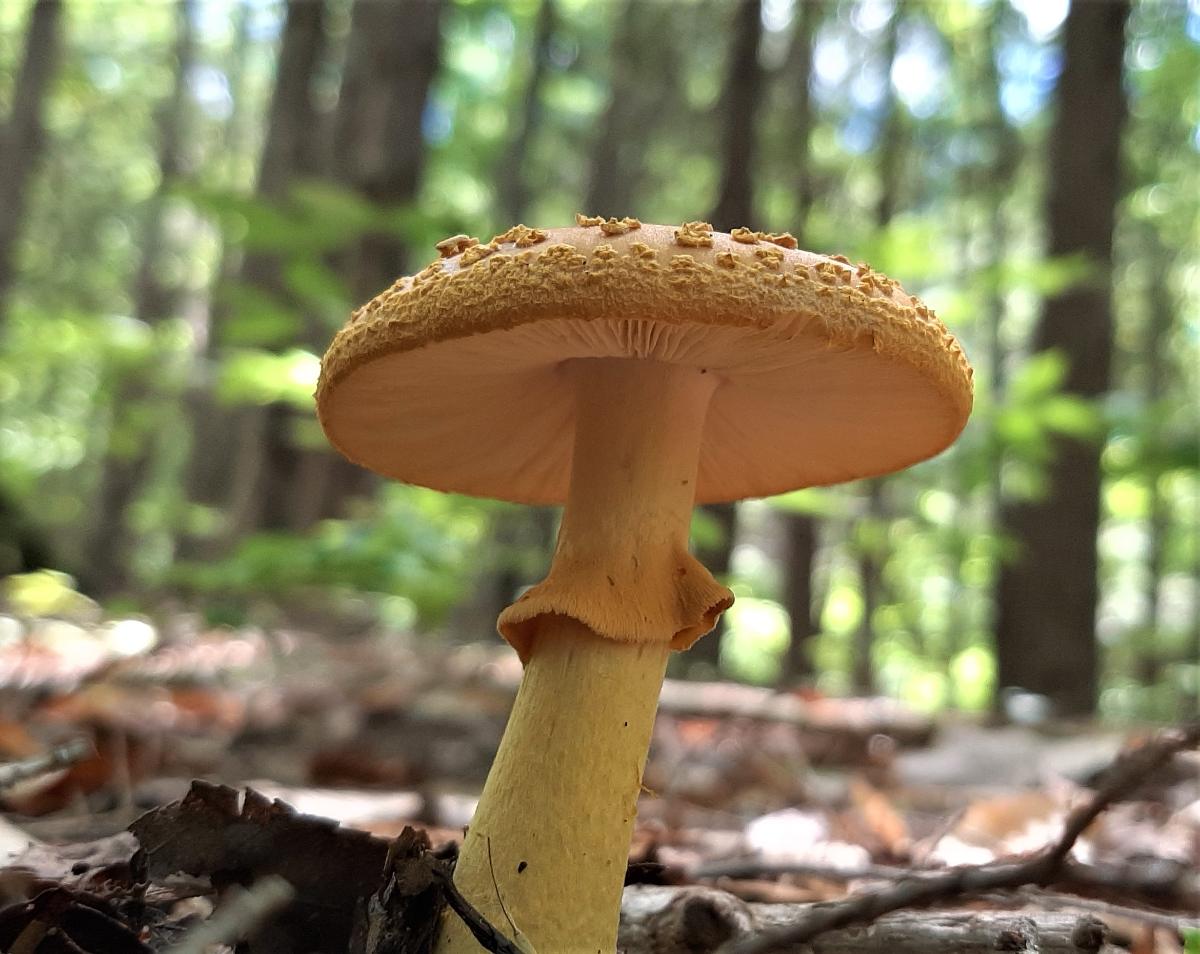
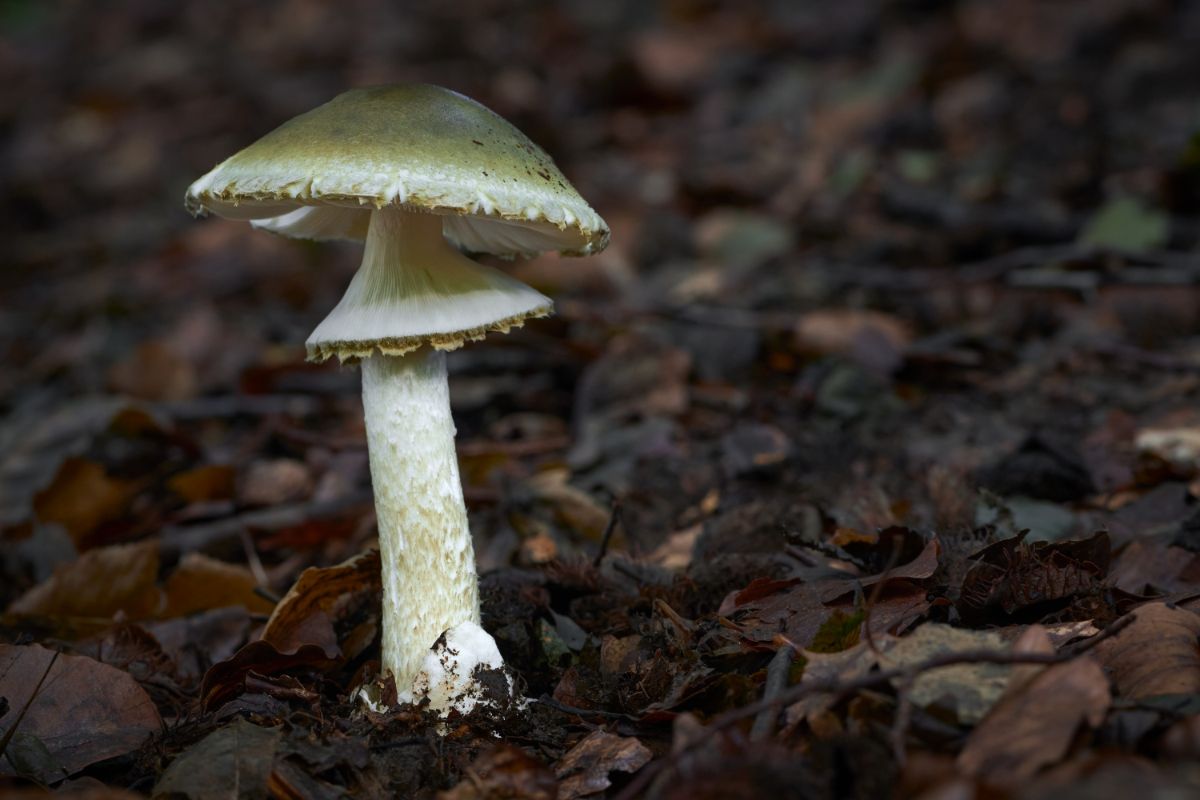
Chlorophyllum Mushrooms
Many mushrooms have distinct-looking rings on their stems. For example, the false parasol has a ring that looks like a napkin holder near the top of its stalk. Some species have rings that can move up and down the stem but are sturdy enough that they don’t break down or fall off.
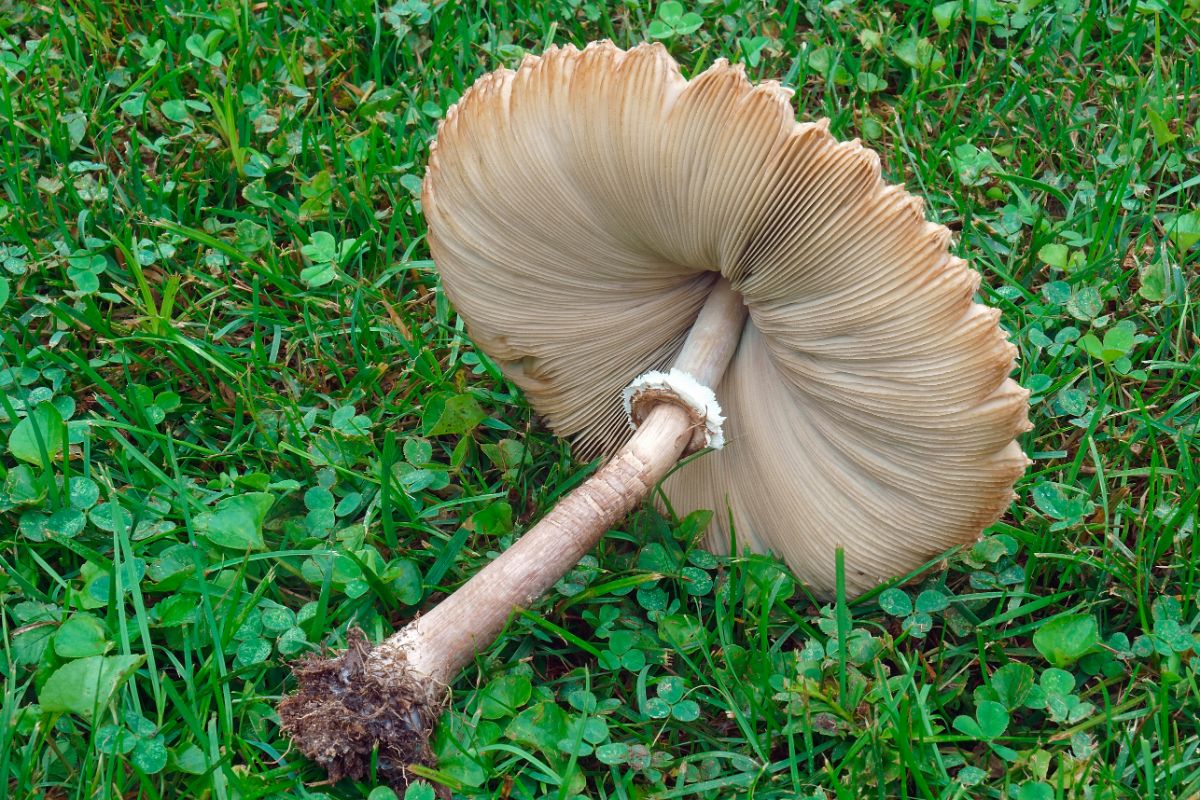
Agaricus Mushrooms
Agaricus mushrooms have skirts around the stem, and they vary quite a bit among the species. The details of the skirt are commonly an important identification point. The skirts might develop two layers with different upper and lower surfaces.
The textures range from membranous to fibrous. The popular and widespread button mushroom is part of the Agaricus family, and it has a skirt around the upper stem. Next time you are cooking with button mushrooms, take a moment to look at the gills and stem. The gills might still be covered by the partial veil. Or the veil may be broken, and a ring of flesh is present around the stem.

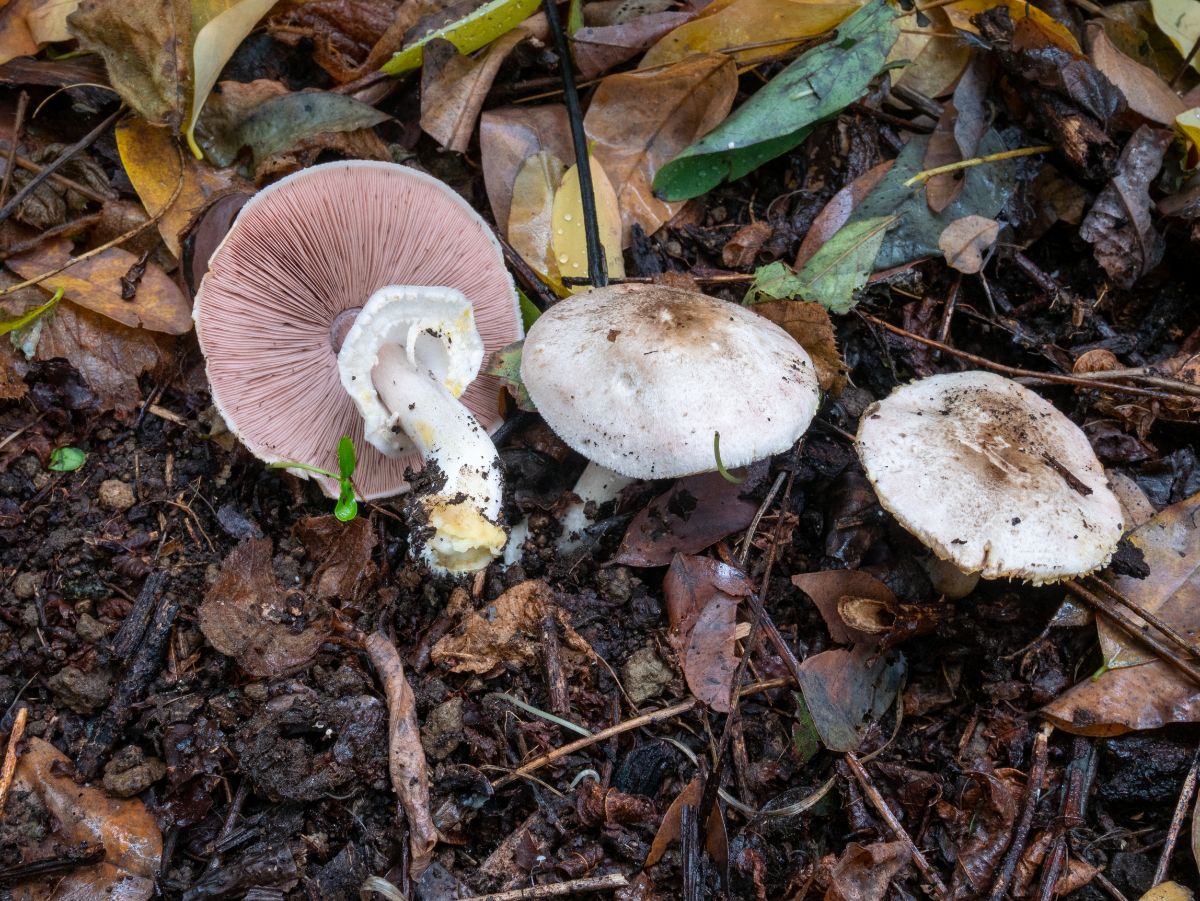
Frequently Asked Questions About Mushroom Skirts and Rings
Why do some mushrooms have rings on their stems while others don’t?
Whether a mushroom has a ring or skirt around its stem depends entirely on its developmental process. Some mushrooms form a partial veil (which protects the developing gills), and this veil breaks as the mushroom grows. The remnants of the veil form a skirt or leave a ring mark around the stem. Species in families like Agaricus (including common button mushrooms) and Amanita typically have prominent rings. Other mushroom families naturally develop without this protective partial veil structure and, therefore, never form rings on their stems. This characteristic is genetically determined.
Are mushroom rings and skirts important for identification purposes?
Absolutely! Rings and skirts are crucial identifying features. The presence, position, texture, and permanence of stem rings and skirts can lead to a positive identification. Always check to see if there is a ring or skirt around the stem. And, pay attention to whether it is fragile, movable, or fixed to the stem.


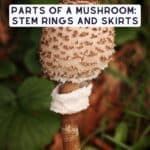






Leave a Reply